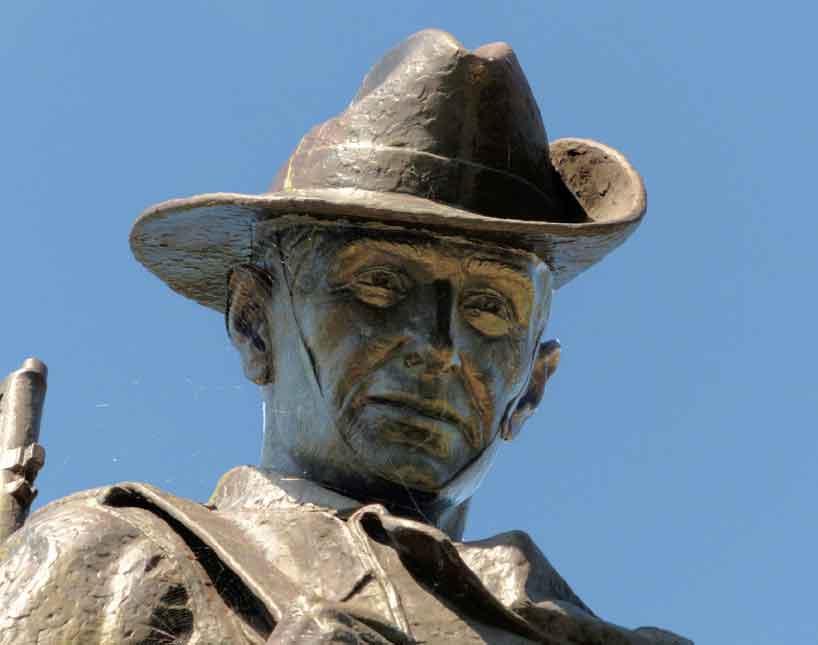• Itinerary Four starts at Exit 13 from the E15/A1 Motorway, direction Péronne, at Assevillers and heads east to Péronne, over the Canal du Nord, through Rancourt to Bapaume.
• The Route: Assevillers; Belloy and the Alan Seeger Memorials; the French National Cemetery, Villers Carbonnel; the British and Indian CWGC Cemetery, La Chapelette; Péronne – the Historial, the town hall; Mont St Quentin, 2nd Australian Div Memorial/Remembrance Trail; Bouchavesnes-Bergen – Private Memorials to French soldier Fuméry and French Aspirant Calle and the 106th Infantry Regiment Memorial, Marshal Foch Statue; Rancourt – German Cemetery, CWGC Military Cemetery, the French National Cemetery, the Souvenir Français Chapel; Sailly-Saillisel British CWGC Cemetery; the French Memorials, le Transloy; the German Cemetery and Memorial, Villers au Flos; Bapaume.
• Extra Visits are suggested to: Biaches – Memorials in Biaches local cemetery, French Colonial Memorial/ 2nd Lt Brocheriou; Remains of German Cemetery, Flaucourt; French National Cemetery; Ecoust St Mein HAC Cemetery; Bullecourt – Letaille 1917 Australian Museum, Slouch Hat Memorial, Digger’s Park Memorial, Memorial to Missing.
• [N.B.] The following sites are indicated: Vaucourt Copse CWGC Cem, Grave of Pte McIver, MC, MM + Bar; Nr Bullecourt – Memorial to 15th Bn Can Highlanders.
• Planned duration, without stops for refreshment or Extra Visits: 3.0 hours.
• Total distance: 28.8 miles.
• Péronne-Assevillers Motorway Exit 13/0 miles/GPS: 49.89605 2.84506/RWC
There is a motorway complex nearby with petrol station, shop, tourist information, cafeteria and fast food outlets. The ***Ibis Styles Hotel, Tel: + (0)3 22 85 78 30, e-mail: h0560@accor.com makes an ideal and comfortable starting base for touring the battlefield if using the Eastern Approach.
From the motorway exit, SET YOUR MILEOMETER TO ZERO. Immediately turn left onto the D1029 and then left towards Belloy-en-Santerre on the D79. Take the second left into the village and stop in the square outside the church/Mairie.
• Belloy – Alan Seeger Memorials/0.9 miles/10 minutes/Map 1/35/GPS: 49.88269 2.85593
This powerfully fortified village was taken by the French on 4 July (American Independence Day) 1916, their advance having been faster and deeper than the British to the north. The famous French Foreign Legion was ordered to carry the position at bayonet point at 0600 hours. The Michelin Company produced a series of small battlefield guidebooks from 1919 as a memorial to their employees who were killed in the war, and the Legion’s charge is described in the Michelin Somme Guide thus:
“Deployed in battle formation, they charged across a flat meadow 900 yards broad. When 300 yards from their objective, machine-guns hidden in the path from Estrées to Belloy were suddenly unmasked and a deadly fire mowed down the French ranks. The 9th and 11th Companies sustained particularly heavy losses, all the officers falling. One of these companies reached the objective under the command of the mess corporal. Belloy was captured and 750 Germans were taken prisoners.”
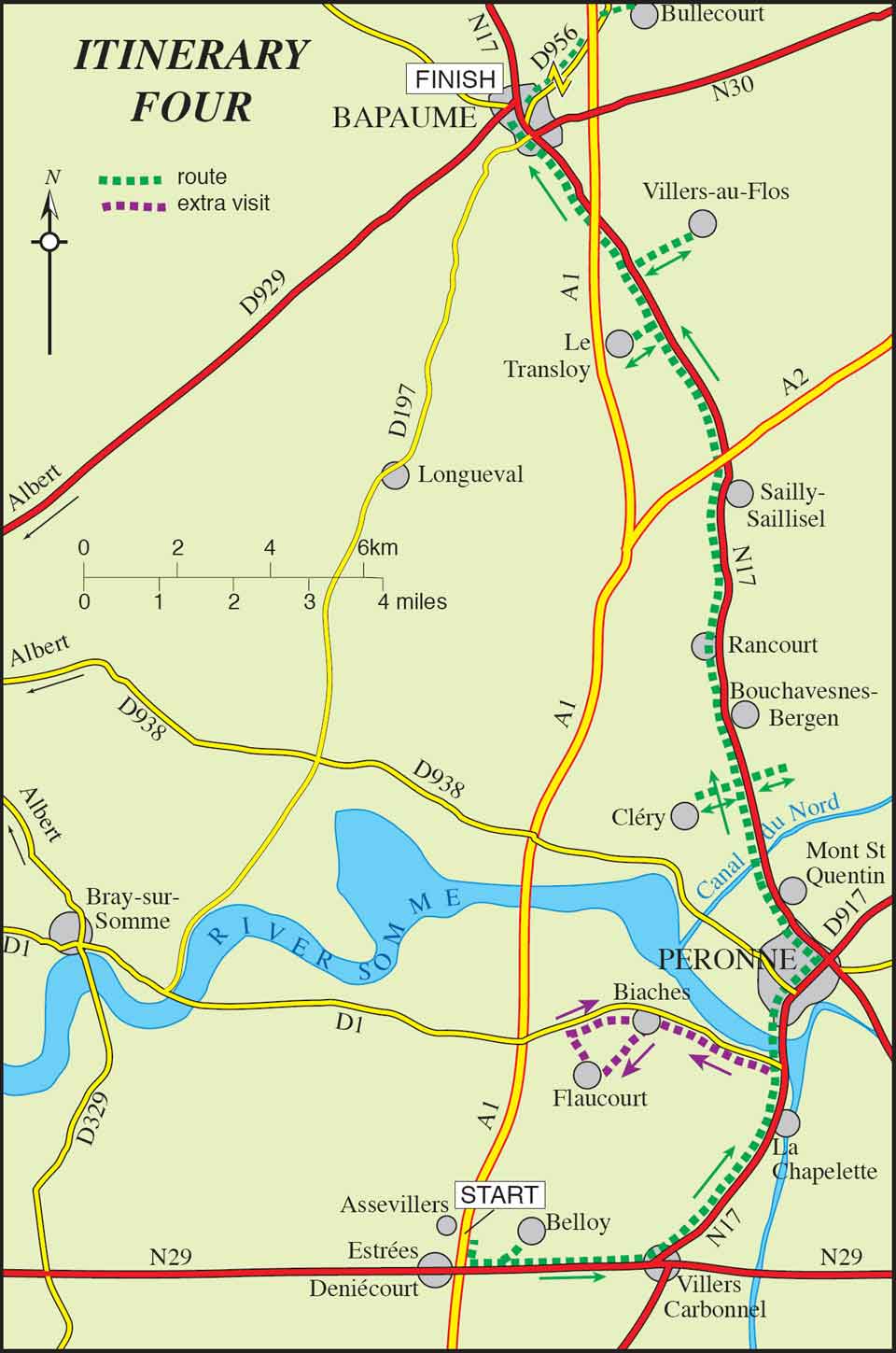
Among those to be mowed down was the talented and promising young American poet, Alan Seeger, who had been living in France when war was declared and who immediately volunteered. He served with the Legion in the Reims and Aisne sectors throughout 1915 and in the spring of 1916 wrote the prophetic poem Rendezvous, that was to guarantee his immortality. Its opening lines are:
I have a rendezvous with Death
At some disputed barricade ….
After the war, his grieving parents paid for a Memorial Bell to be placed in the belfry of the rebuilt church of Belloy. Its peal represented his voice, still singing over the land he grew to love. In 1940 the church was again badly damaged but a new bell continues to sing out in his name. The village children are taught some lines of their ‘poète américain’ and there is a Plaque to him on the Mairie/school, opposite the church and an Information Board with English translation on the reverse.
Seeger was posthumously awarded the Croix de Guerre and the Médaille Militaire. He is thought to be buried in the French National Cemetery at Lihons (see Itinerary Three) where a Plaque was unveiled to him in 2006. Alan Seeger is the uncle of the folk singer Pete Seeger. The village war Memorial also bears the name of ‘Alain’ Seeger and honours the French Foreign Legion, July 1916. On the rear of the Memorial the fierce defence of Belloy by the 117th RI in May/June 1940 is commemorated. The road is called Rue de Catalogne, and the ‘Men from Barcelona’ are also commemorated in the church.
Return to the D1029, turn left direction Péronne and continue to just short of the junction with the N17. Stop at the French cemetery on the left.
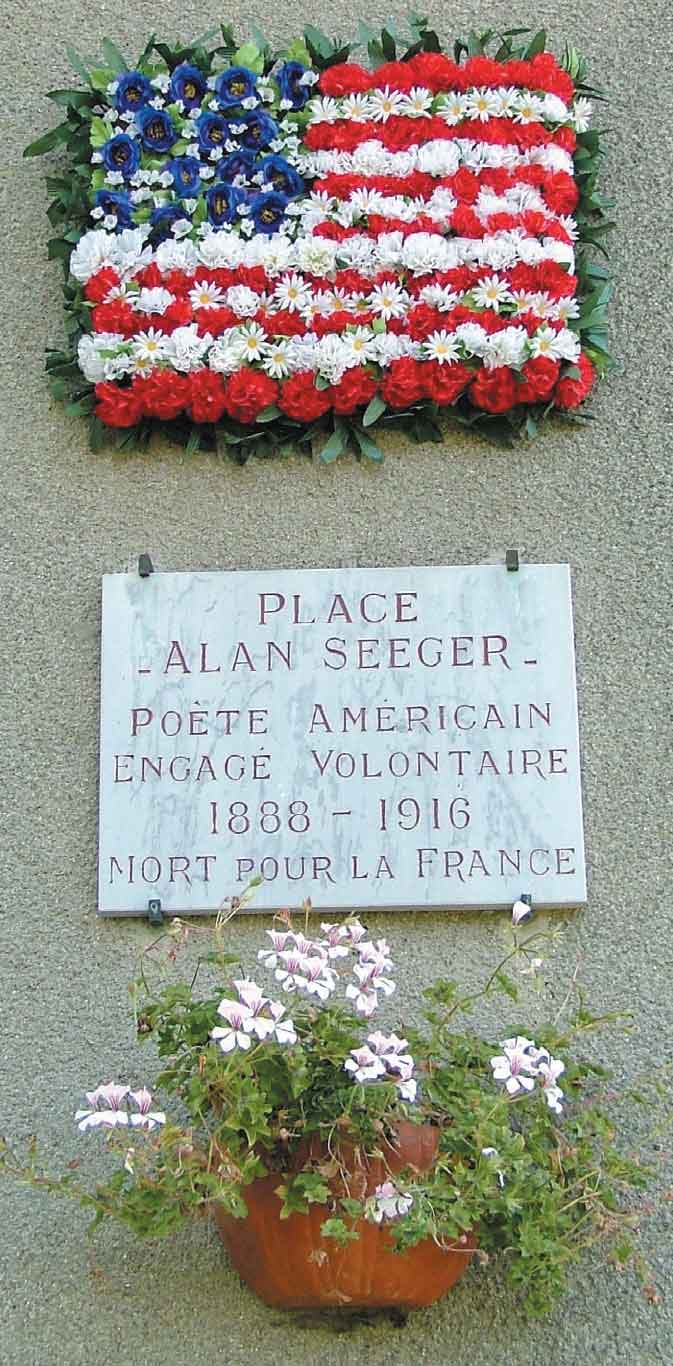
Plaque to poet, Alan Seeger, Belloy
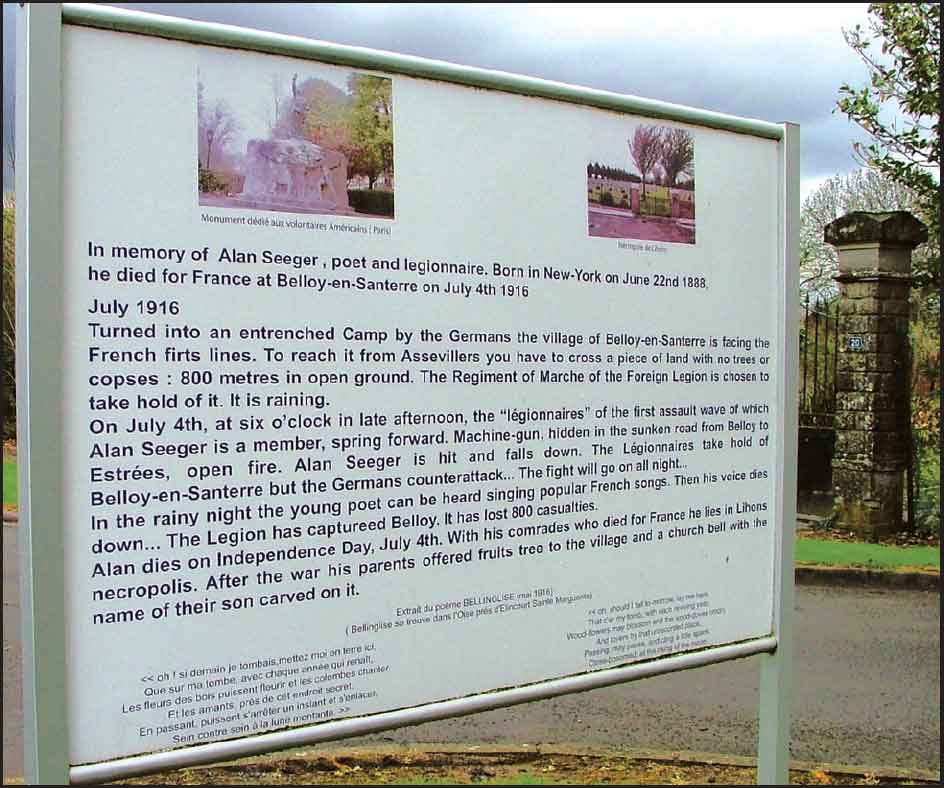
Alan Seeger Information Board, Belloy
• French National Cemetery/Chinese Graves, Villers Carbonnel/4 miles/10 minutes/Map 1/3/GPS: 49.87638 2.89326
The Cemetery contains 2,285 burials, of which 1,295 are in two mass graves. Fifty-nine men are named in Ossuary 1 and thirty-five in Ossuary 2. Inside the Cemetery is the local World War I Memorial. Muslim headstones and Latin crosses are often back to back. In 1941 eighteen French bodies from World War II were exhumed and reburied here. In the adjoining local cemetery there is a plot hidden in trees at the back containing three Chinese CWGC graves from October 1918. The concrete frames of the graves are inscribed ‘Concession à perpétuité’. Normally French graves have a limited concessionary period and signs offering graves for reburials are often seen in French cemeteries. It is pleasing to know that the remains of these obscure Chinese labourers, who came so far to give their lives, will always be preserved here, although not always in pristine condition.
Turn left on the N17, direction Péronne and the Historial and stop at the British cemetery some 3 miles further on to the right.
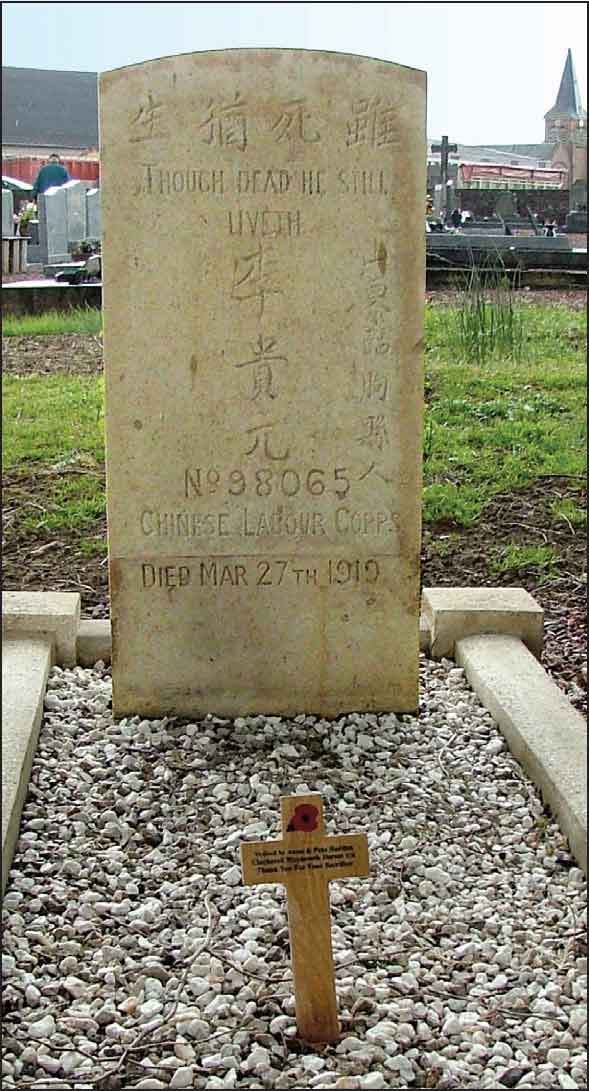
Chinese Headstone, French National Cemetery, Villers Carbonnel
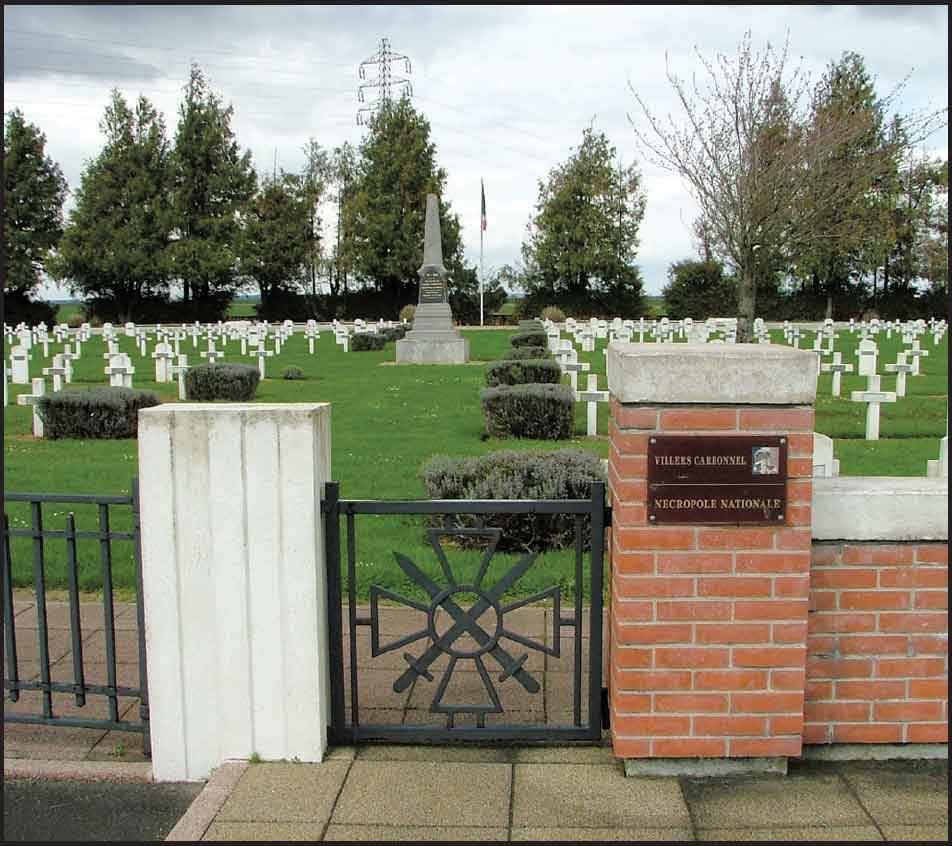
French National Cemetery, Villers Carbonnel
• La Chapelette British & Indian CWGC Cemetery/6.8 miles/5 minutes/Map 1/37/GPS: 49.90564 2.92997
One of the later Cemeteries to be completed (it was still listed in the 1929 version of Silent Cities as one of the cemeteries which ‘for various reasons … have not yet been constructed’) it contains approximately 250 British, Australian and ‘Christian Indian’ graves from 1917 and 1918 and a plot of some 325 Indian Labour Corps from the same period on the left. This stretch of road for about 500 yards each side of the Cemetery runs immediately parallel and alongside what the French called ‘Raoul Trench’.
Over the road the Campanile Hotel has now become the 2 star Fasthotel Relais and is completely renovated. Good initial reviews. Tel: +(0)3 22 84 22 22. E-mail: peronne@directfasthotel.com
Continue to the traffic lights at the junction with the D1, just before the River Somme.
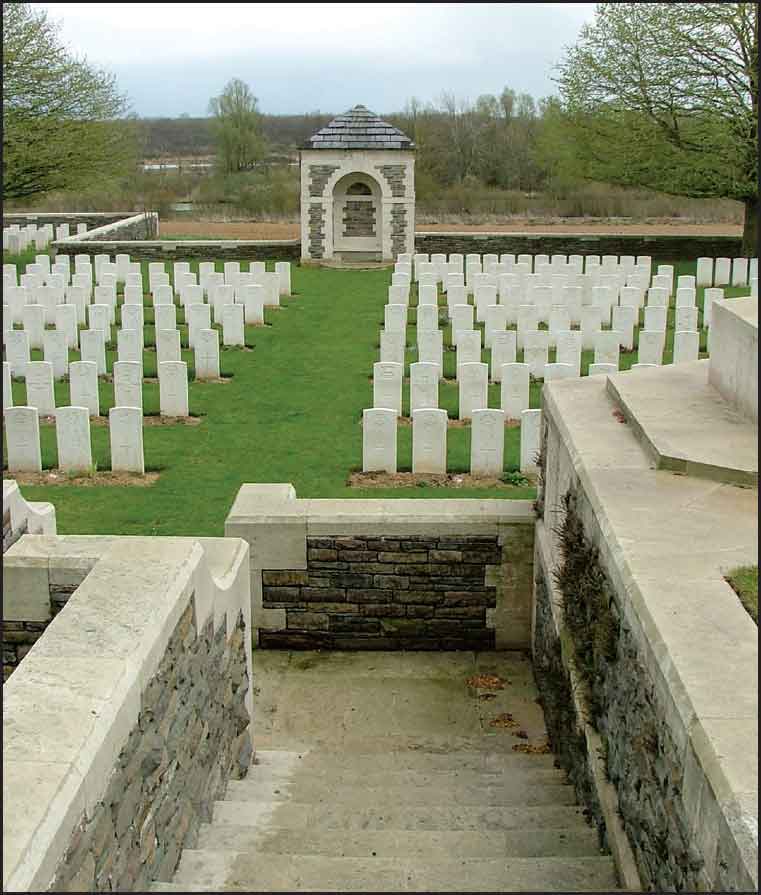
La Chapelette British & Indian CWGC Cemetery, with the River Somme beyond
Extra Visit to Biaches (Map I38/38a/39, GPS: 49.92493 2.90806) Local Cemetery, French Colonial Memorial & Tomb of 2nd Lt Brocheriou (GPS: 49.91758 2.89703); Wartime German Cemetery, Flaucourt (GPS: 49.91202 2.86716) & French National Cemetery at Biaches (GPS: 49.92760 2.88712).
Round trip: 9.1 miles. Approximate time: 50 minutes
Turn left and continue to Biaches.
Biaches was occupied by the Germans on 28 August 1914. During the 1916 Somme Offensive, the French advance on Biaches was so rapid that they took the village on 10 July 1916 after an intense and bitter struggle for a strongly fortified position known as the Herbécourt Redoubt, which was taken, when, according to the Michelin Guide, ‘a Captain and eight men, with “extraordinary daring” crept up to and entered the redoubt. The garrison, which still numbered 112 men and 2 officers, lost their presence of mind and surrendered without offering any resistance.’ Several strong counter-attacks followed, on 15 and 17 July and the Germans temporarily regained the village, only to be driven out again on the 19th. The loss of the village, the last defence along this road before Péronne, was a great blow to the Germans, hence their bitter fight for it. The French remained in the sector until January 1917, when it was taken over by the British 48th (S Midlands) Division, which included battalions of the Royal Warwickshire Regiment. It was a bitterly cold winter, with snow and hard frosts and very intense fighting took place with the enemy. The 7th Battalion occupied part of Biaches, the village green being in No Man’s Land, but a pump in the centre was apparently used by both sides. The Germans retreated from the village to the Hindenburg Line in March 1917, leaving it in complete ruins. The Warwicks then moved on and entered Péronne (see page 31). They made a strong impression on the village and in January 1922 Leamington Spa held a public meeting (typical of many such gatherings throughout Britain) to vote that because of the 7th Warwicks’ connection with Biaches (and as Leamington was famous for its health-giving water and the village pump had provided the Warwicks with water in their hour of need) the town should ‘adopt’ the devastated village. Members of the British League of Help had already visited the damaged areas and they reported, with the help of photographs, the rubble and the appalling plight of the inhabitants (who had numbered 446 before the war and who were now reduced to 229, living in huts). By August £331 5s 10d had been raised. £200 was spent on fruit trees, £50 on garden and farm seeds and the rest on ‘Communal Equipment’, which included public weighing machines, fences and gates for the rebuilt cemetery. In June 1930, the Mayor of Leamington, Dr R. F. Berry, and the Town Clerk, Mr Leo Rawlinson, joined a large group of British local government officials who first visited Paris, where they were greeted by the President of the Republic in the Elysée Palace and hosted to a grand dinner in the Hôtel de Ville. They then moved on to Amiens by train and thence by road to the various villages that they had ‘adopted’. At Biaches, Dr Berry and Mr Rawlinson inspected the gifts bought with the money raised by the citizens of Leamington and presented a fine illuminated address (which still hangs proudly in the Mairie) to mark the visit. A marble Plaque (now in the Mairie awaiting a suitable base around the green), stating ‘Don de Lamington [sic] Spa’, was attached to the weighing machine, now dismantled, and the school children were granted a day’s holiday. Many other Somme villages benefited in equally practical ways. Montauban’s water supply and lighting system were supplied with funds from Maidstone, for example.
In the village turn left on the rue de Barleux at the edge of the green in front of the Mairie. Continue to the left of the Mairie and fork right then continue to the cemetery on the right.
Biaches Local Cemetery. On the right-hand gatepost is a marble sign reading ‘Don de Lamington [sic]-Spa’ (see details of the ‘adoption’ above) and on the left a sign reading Tombes de Guerre. In the cemetery is a well-maintained memorial to 33 Cuirassiers of the 9th Regiment, who fell on 24 September 1914 at la Maisonnette. Next to it is another mass grave to 12 Chasseurs Alpins of 7th Battalion who died at la Maisonnette on 28 August 1914.
Continue to the junction and go right again. As the un-made, narrow road descends through a small copse, stop opposite a yellow sign in the bank, on the right at the top of some steps, which directs you to the memorial.
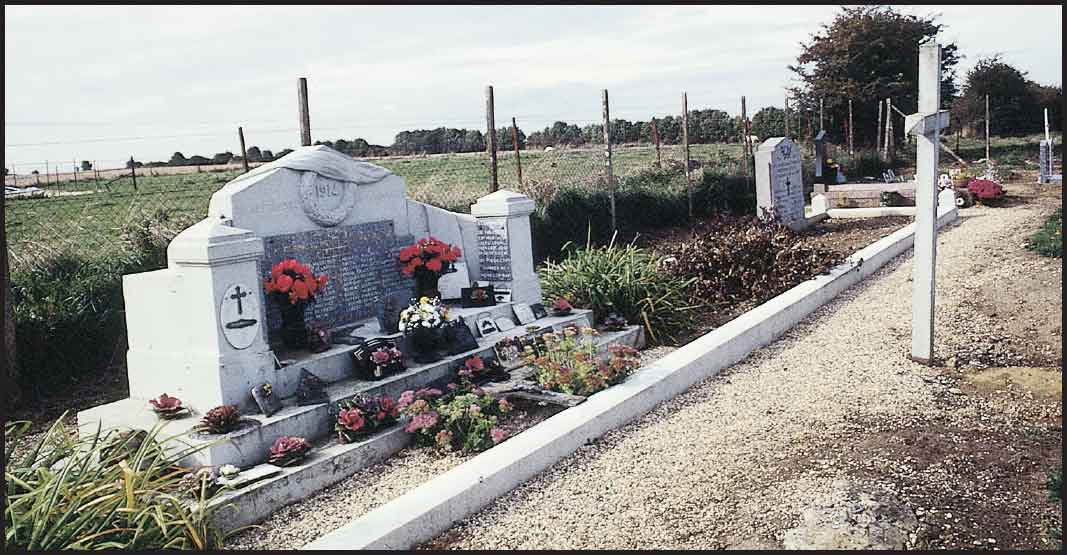
French 7th Battalion Chasseurs Alpins and 9th Regiment graves, Biaches Local Cemetery
The French Colonial Memorial set in a glade, commemorates the Colonial Forces who in 1916 fought in this sector and who died here.
Behind the Memorial is the grave, marked by a white cross, of 2nd Lt Marcel Brocheriou, of the 22nd RI of Lille, Croix de Guerre, Chevalier de la Légion d’Honneur, killed on 6 August 1916. (In contrast to the good state of maintenance of this Memorial, that to the 56th Battalion Chasseurs à Pied, which was in the nearby hamlet of la Maisonnette, was demolished in 1994 by the farmer on whose ground it stood and no trace of it now remains.)
Continue along the road to the outskirts of Flaucourt.
In a field to the right is a brick shelter with the clear plaque, ‘Zur Ehre der Fur Kaiser ond [sic] Reich Gefallen Sohne Deutschlands’ (‘To the sons of Germany fallen for Kaiser and for State’).
Originally this was a German Cemetery and until the mid-1970s metal name plaques were still in place on the remains of wooden crosses in a semi-circle round the shelter. This rare German memorial has withstood the fate of many other wartime German monuments that were often destroyed by resentful civilians returning to their destroyed villages after the war or dismantled by farmers whose ploughing they impeded.
Continue to the crossroads and turn right. Continue through the village, noticing the remarkable painted Poilu by the Mairie on the right and at the junction with the D1 turn right. Continue to the French cemetery on the right.
Biaches French National Cemetery contains 1,362 graves, of which 322 are in two mass graves. It was completely renovated in 1974.
Continue and return to the N17 and rejoin Itinerary Four.
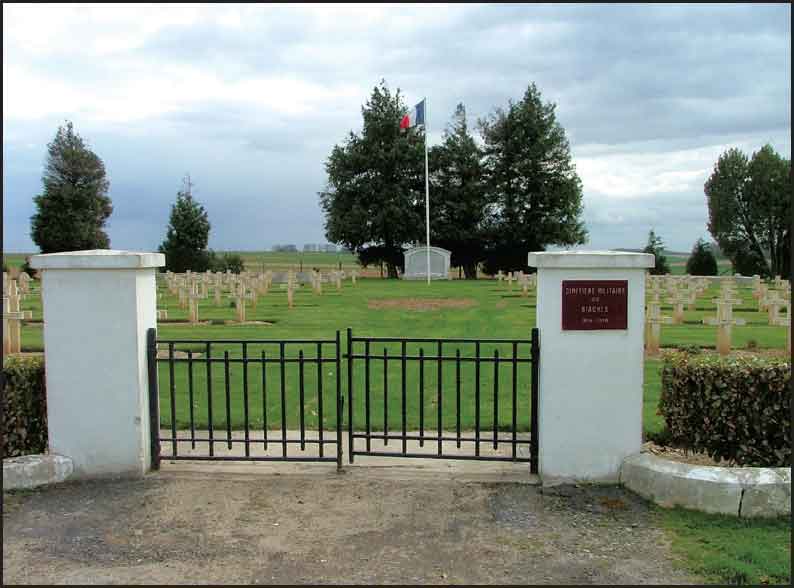
Biaches French National Cemetery
Continue, passing on the right a small road, signed to Flamicourt (Bvd des Anglais).
It was here on 12 October 1924 the first rebuilt bridge across the River was opened. It was funded by Blackburn under the British League of Help and was named Blackburn Bridge.
Continue into Péronne, crossing the Canal du Nord and the Somme and follow signs to the town centre. Turn left at the signs to the Historial and park in front of it if you are stopping.
• Péronne/8.7 miles (GPS: 49.92885 2.93245) For details of Péronne and the Historial, see Eastern Approach, page 30
Note: the Péronne Tourist Office is to the immediate right on the square as you face the entrance to the Historial, at 16 Place André Audinot, Tél : + (0)3 22 84 42 38. E-mail: accueil@hautesomme-tourisme.com, www.hautessomme.tourisme.com
Beside the Historial (which is fully described on page ??) is a hall marked ‘Salle Mac Orlan’. It was named in honour of Pierre Dumarchey, born in Péronne on 26 February 1882. Dumarchey was educated at Orleans, then moved to Paris to artistic and literary life. He became friendly with Picasso and the fellow avant-garde poet (also playwright and critic) Wilhelm de Kostrowitzky, whose nom de plume was Guillaume Apollinaire. (Apollinaire served with the infantry in Champagne, was badly wounded in March 1916 and gassed, and died on 9 November 1918 of influenza in Paris.) Like Apollinaire, Dumarchey took a nom de plume – ‘Mac Orlan’. After considerable travels he joined the French Foreign Legion – before the war broke out – and served on the Somme. In 1916 Mac Orlan was wounded at Cléry. One of his most famous war-time works was the poem Chanson de la Route de Bapaume (‘Song of the Bapaume Road’). Like Charles Sorley’s All the Hills and Vales Around, the poem hides a bitter message behind an apparently jolly marching song rhythm. After the war Mac Orlan wrote novels, one of which, Quai des Brumes (‘Quay of Mists’), was made into a popular film.
Return to main road, turn left, passing the town hall on the left on Roo de Kanga! Continue following signs to A26 Bapaume and turn left on to the D1017, direction Bapaume/A26/Arras/Calais. Continue to Mont St Quentin. Stop at the memorial on the left.
• Australian 2nd Division Memorial/RB/10.6 miles/10 minutes/Map 1/40a/GPS: 49.94757 2.93273
This fine figure of an Australian ‘Digger’ with bronze bas relief plaques of Australians in action on each side of the base, is post-World War II. The original 1925 Memorial portrayed a Digger bayoneting a German eagle and was objected to and destroyed by the occupying German soldiers in 1940. There is a model of it in the Historial (qv). The French and Australian flags fly to each side of the statue. Behind the Memorial is a Ross Bastiaan bronze bas relief Plaque unveiled by Senator John Faulkner, Australian Minister for Veterans’ Affairs, on 3 September 1993. Around the base of the statue are informative Plaques telling of the progress of the battle. It is Point Number 2 on the Remembrance Trail (see below).
Mont St Quentin, on the right, 390ft high at its apogée, protected the northern approaches to Péronne. Here the Germans sited their heavy artillery and built strong entrenchments protected by thick barbed wire and chevaux-de-frise. The hill was riddled with underground galleries and huge, well-furnished shelters. Before their retreat to the Hindenburg Line in March 1917, the Germans mined these defence works and blocked the entrances to the underground tunnels, setting light to the wooden props and causing a fire that rumbled on for several days. They re-occupied the area in their March 1918 Offensive, and remained there until the night of 30 August when they were attacked by the Australian 2nd Division ‘bombers’ who then held the ground despite three fierce counter-attacks by the Prussian Guard the following day. Monash had achieved surprise by building several bridges over the Somme (the Australian’s start line ran roughly parallel to this road on the other side of the river which is in the valley beyond the statue – Point Number 3 on the Remembrance Trail gives a good overview) and using them to move his main force against the Hill rather than Péronne itself. As the troops were tired they were issued with rum to lift their spirits and at 0500 hours on 31 August the 17th and 20th Battalions of the 2nd Division charged directly at the hill ‘yelling like a lot of bushrangers’. Péronne itself was taken on 2 September, the Australians winning four more VCs and suffering some 3,000 casualties in all.
Detail of Digger’s face
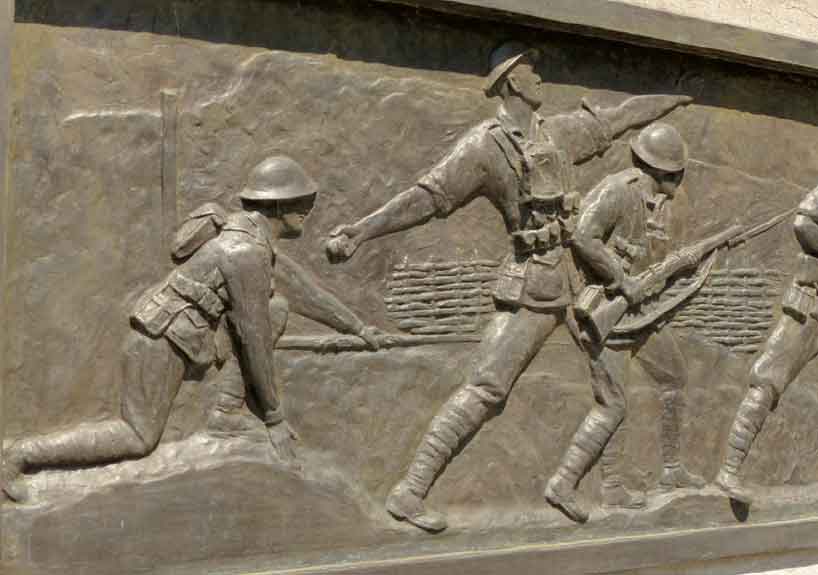
Detail of Bas Relief
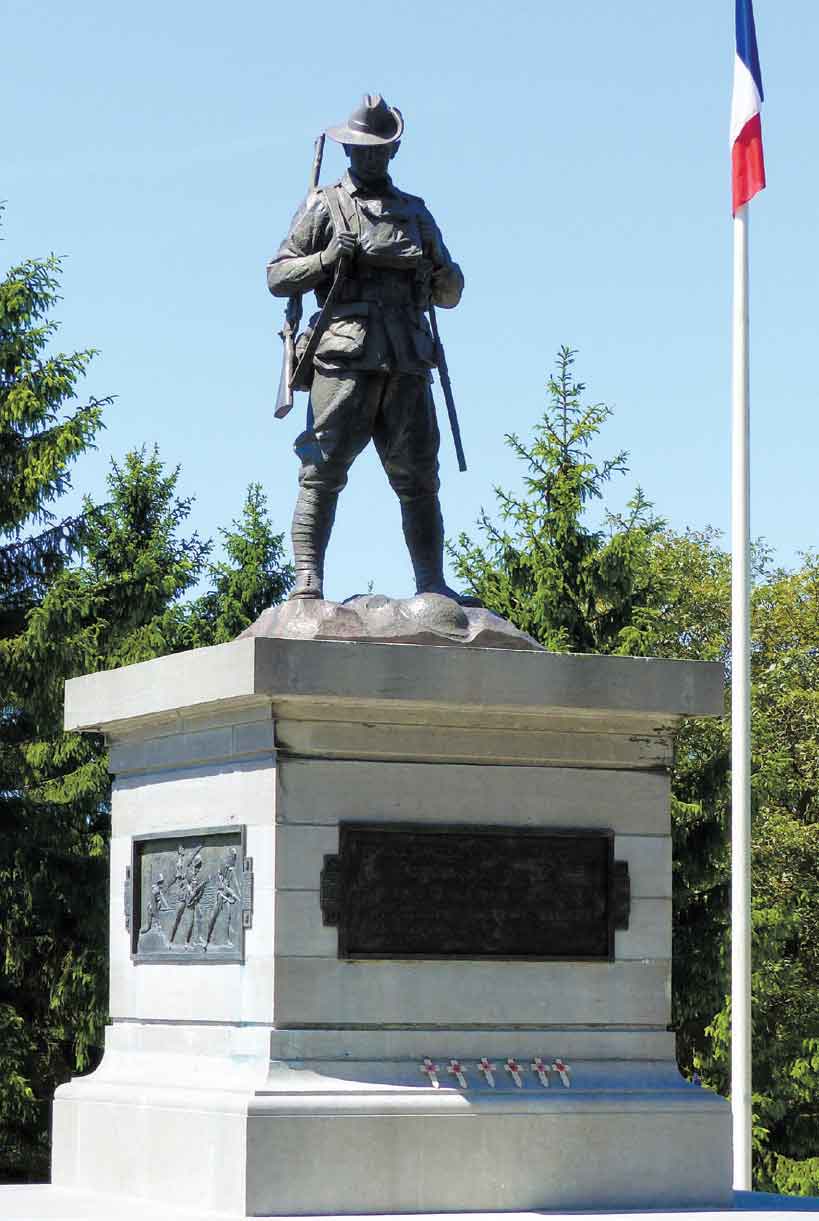
Memorial to Australian 2nd Division, Mont St Quentin
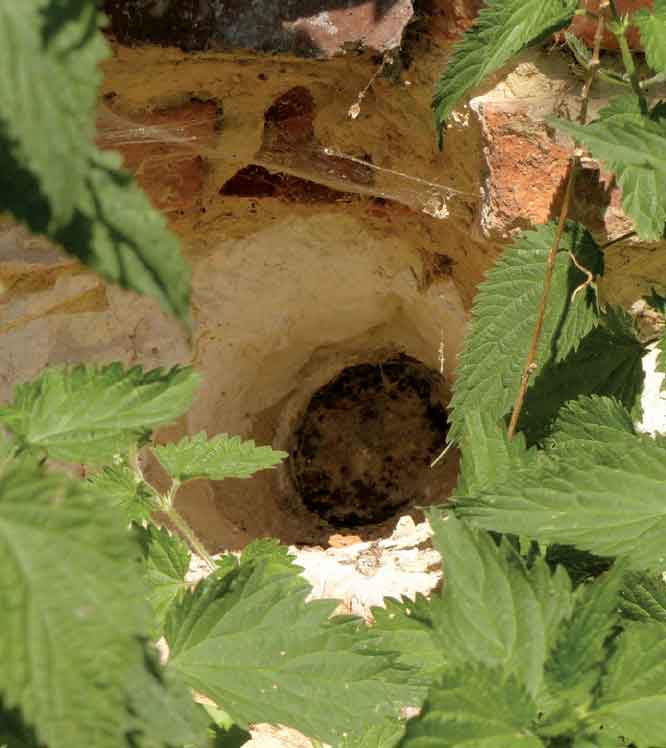
Australian Mont St Quentin Remembrance Trail Point No 5, Embedded Shell
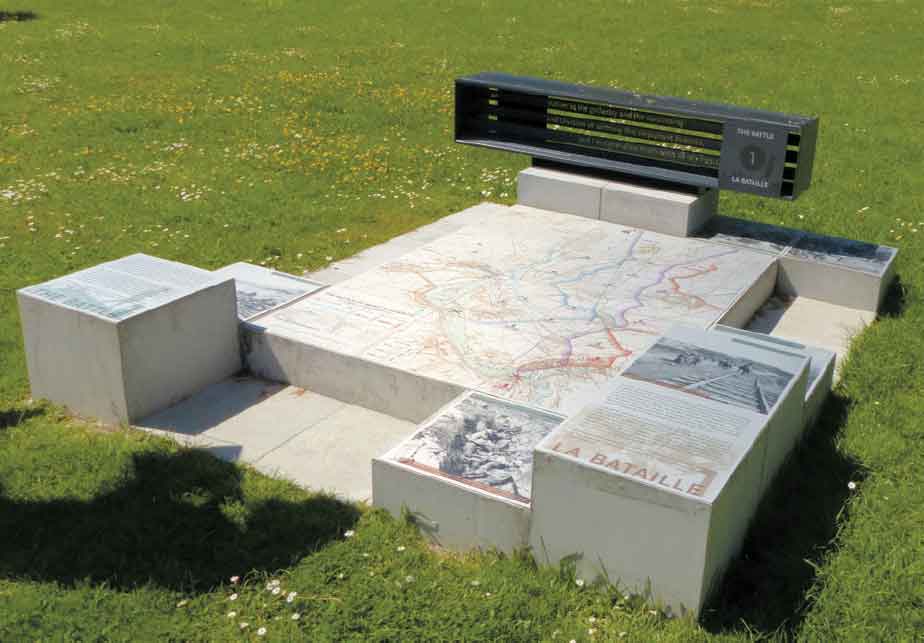
Australian Mont St Quentin Remembrance Trail Point No 1, Old Church
In April 2015 an Australian Remembrance Trail was inaugurated around the village. It was researched and installed by the Historial with Australian funding. See the Historial entry on page 30 for details of the Australian Salle which gives a good background to this trail. There are 6 Stopping Points, marked with flat stones (easy to miss if you are unaware of their presence) each with a theme, maps, quotations and photographs: Point No 1. Near the old church (49.94748 2.93465) with a map to locate the battle and details of the other points. Point No 2. Around the Australian 2nd Div Digger Memorial. Theme: ‘Memory and Loss’. Point No 3. View Point over Péronne and site of Elsa Trench (in field directly below). Theme ‘Determination’. Point No 4. Bouchavesne Crest by Crucifix. Theme: ‘Determination’. Point No 5. Shows a shell still embedded in the wall of the ruined village, then heavily fortified. Theme: ‘Destruction’. Point No 6. German trench line in the wood (better visibility when leaves are off trees.) Theme: ‘Courage’.
Three Australian VCs won in this area on 1 September 1918 were: Pte Robert Mactier, 23rd (Victoria) Bn, AIF, (buried in Hem Farm Cemetery (qv), Map N6, Itinerary Three); Sgt Albert David Lowerson, 21st (Victoria) Bn, AIF, (who survived until 1945); Lt Edgar Thomas Towner, MC, 2nd Bn, Aust MGC (who survived until 1972).
Continue, crossing the Canal du Nord, some 2 miles and turn left on the D149 towards Cléry. Continue to the cross on the right at the end of a copse once known as ‘Road Wood’.
• Memorial to Gustave Fuméry & 132nd Infantry Regiment/13.3 miles/5 minutes/Map 1/40c/GPS: 49.96944 2.90398
This Cross, maintained by Souvenir Français, commemorates Gustave Fuméry, aged 20, and 150 comrades of the French 132nd RI, killed here on 4 October 1916 and buried the same day.
Turn round and return to the D1017. Cross the main road to the rough track straight ahead and drive or walk, depending on the state of the track (it can be muddy), to the memorial ahead.

Memorial to Gustave Fuméry
• Memorial to Aspirant Louis Calle, 106th Infantry Regiment/14.1 miles/10 minutes/Map 1/40b/GPS (at end of track): 49.97382 2.91951
This Cross commemorates Officer Cadet Louis Philippe Calle of the 106th RI who, ‘ardent and brave’ fell near Bouchavesnes (up ahead) carrying out a perilous mission with remarkable courage and sang-froid for which he volunteered, on 25 September 1915. The inscription on the stone is so worn that Louis Philippe’s surname could be Galle. The Bouchavesnes war dead are also commemorated on the monument, several families obviously losing two or, in the case of the Melotte family, three members.
Return to the D1017, turn right and continue downhill to the impressive monument on the left.
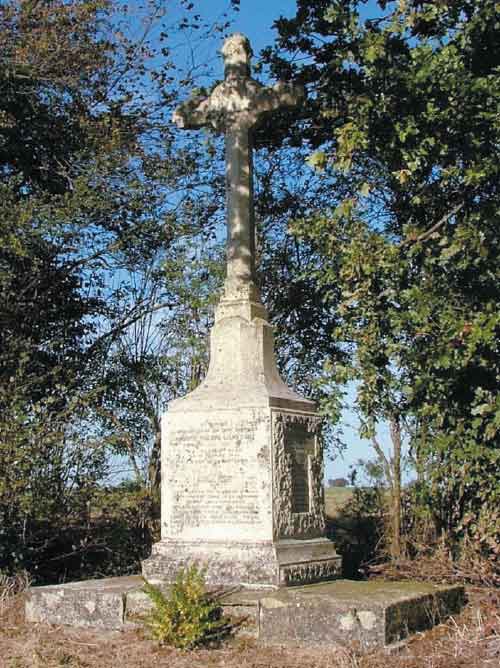
Memorial to Officer Cadet Louis Calle
• Marshal Foch Memorial, Bouchavesnes-Bergen/14.8 miles/5 minutes/Map 1/40d/GPS: 49.98394 2.91577
Bouchavesnes marks the furthest limit of the French advance during the Battle of the Somme. On 12 September 1916, Messimy, the former Minister of War, in command of the Light Infantry Brigade, finally took the village. After the war, a francophile Norwegian industrialist called Wallem Haackon asked Marshal Foch what in his opinion was for the French the most significant battle of the Somme offensive. Without hesitation, Foch named Bouchavesnes. Thus it was that Haackon financed the fine statue of Foch here and the village added the name of Bergen, Haackon’s birthplace, to its own. The Monument commemorates the taking of Bouchavesnes by French forces on 12 September 1916 and by British forces on 1 September 1918, Marshal Foch then being Commandant in Chief of the Allied Armies. A Plaque at the local school with Haackon’s picture commemorates the gift.
Continue on the D1017 to Rancourt. At the edge of the village follow the signs left towards Combles and the German Cemetery and stop.
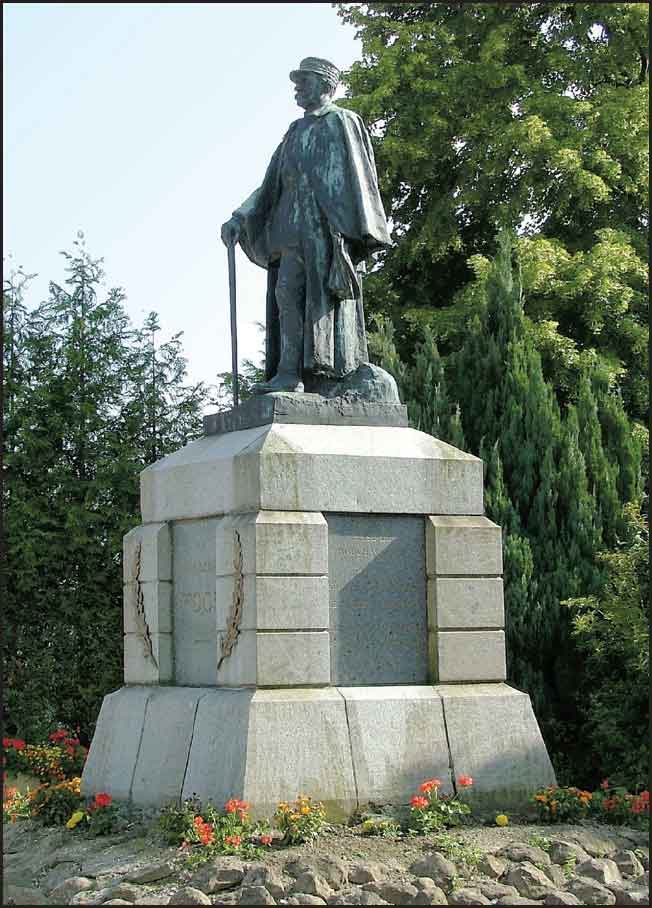
General Foch Statue, Bouchavesnes-Bergen
• German Cemetery, Rancourt/15.8 miles/10 minutes/Map 1/41/GPS: 49.99717 2.90550
This Cemetery contains 11,422 burials, of which 7,492 lie in a mass grave. The crosses here are of grey stone, unlike the other Somme German cemeteries which have black metal crosses. It was in this area on 11 March 1917 that the German air ace Werner Voss, flying with Jasta 2, claimed the 14th of his 44 victories.
Return to the D1017, turn left and continue to the British Cemetery to the left. Park.
• Rancourt Military CWGC Cemetery/16.3 miles/5 minutes/Map 1/42/GPS: 49.99796 2.91056
This small cemetery (ninety-two graves) reflects the fact that the village was taken by the 47th (London) Division – fifty-seven of the graves are of the Division – on 1 September 1918. It was begun by units of the Guards Division in winter 1916.
Cross the road to the chapel and cemetery.
• Souvenir Français Chapel, Museum & Welcome Centre/16.3 miles/15 minutes/Map 1/43
There is a CGS/H Signboard beside the Chapel which was raised as a result of private initiative by the distinguished local du Bos family as a memorial to their son, Lt Jean du Bos, Chevalier de la Légion d’Honneur and Croix de Guerre, age 26, killed on 25 September 1916, and to his comrades of the 94th RI. The maintenance of the Monument was undertaken by Souvenir Français in 1937. There is a Memorial to Jean on the floor as one enters and behind is a photograph of the young man, and a short history of his action. Above the archway of the entrance is an inscription describing how his mother had the idea of erecting the Memorial Chapel and how his father devoted the last years of his life to realising her dream. The Chapel contains many Memorials and plaques which make fascinating reading. One reads (in translation):
“To the memory of Josselin de Rohan-Chabot, Duke of Rohan, Member of Parliament for the Morbihan, Capt in the 4th Bn of Chasseurs à Pied, Chevalier de la Légion d’Honneur, decorated with the Croix de Guerre and the Medal of China, Mort pour la France 13 July 1916 at Hardécourt-au-Bois. A marvellous soldier, loved by all for his profound disregard of danger, his knightly courage, his beautiful qualities as leader of men, a cavalry officer who transferred to the 4th Bn the Chasseurs à Pied, decorated with the Légion of Honour for his magnificent conduct during the first attacks on Verdun when he was wounded. He had only just returned to the front when he was mortally hit on 13 July, a few metres from the German trenches, where he was carrying out an extremely perilous recce for an operation that he was asked to lead.”
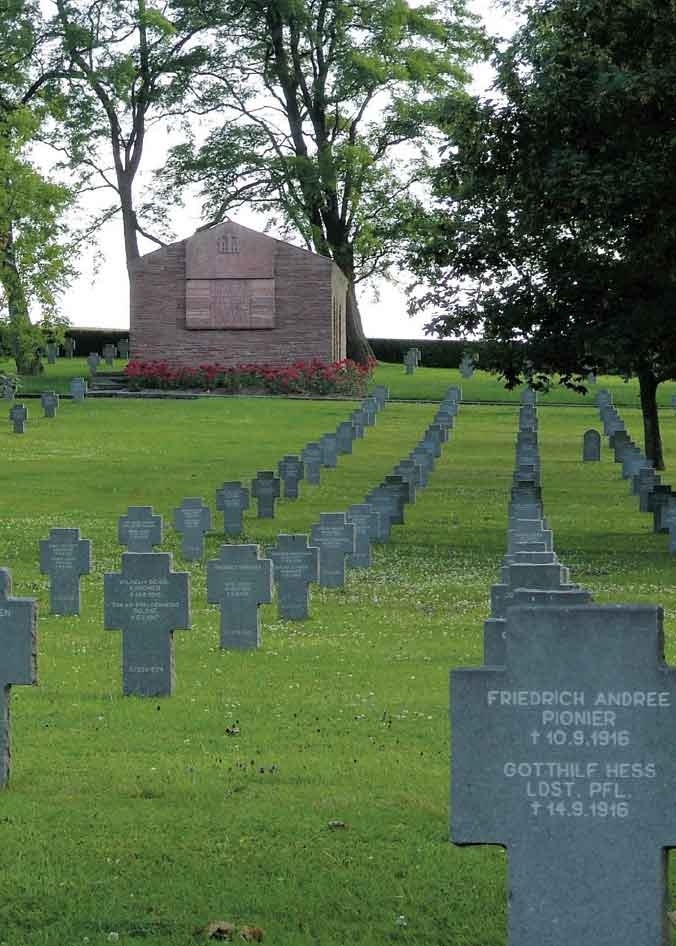
German Cemetery, Rancourt
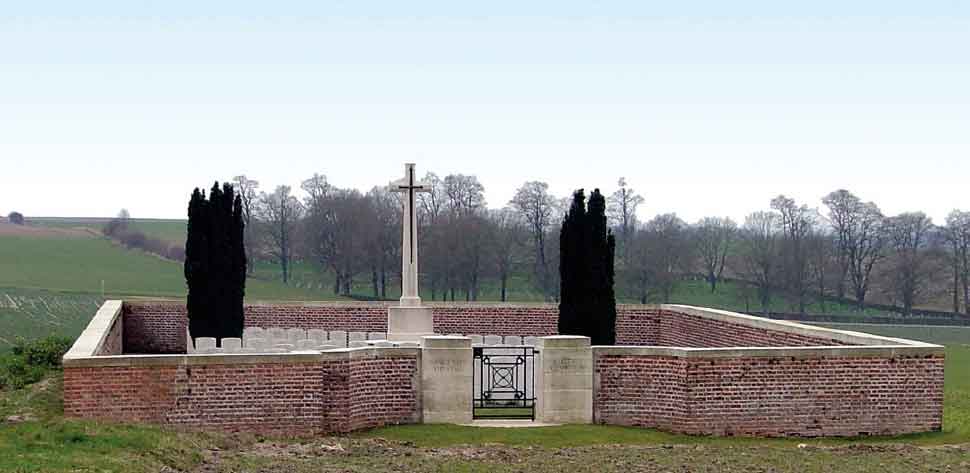
Rancourt Mil CWGC Cemetery
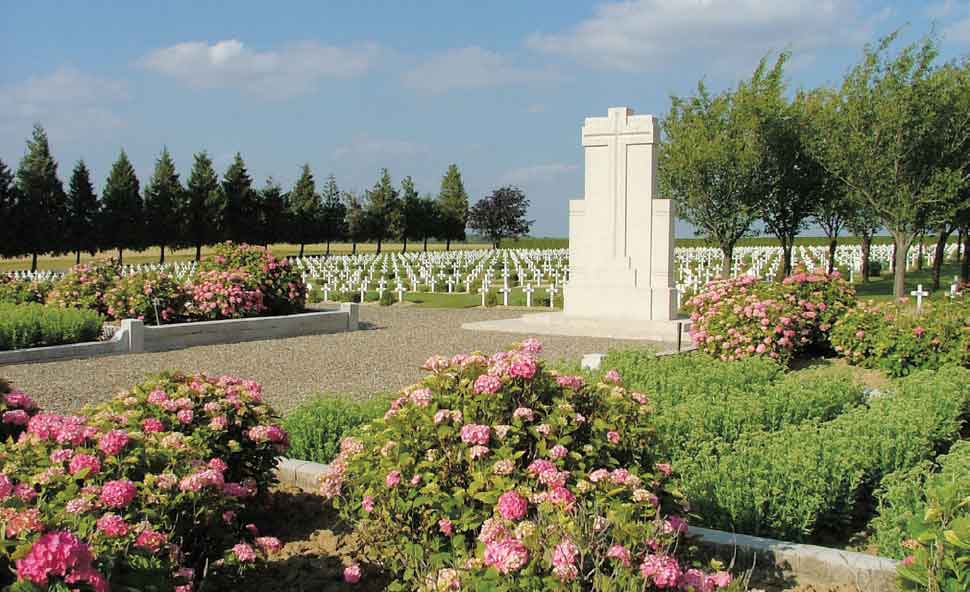
French National Cemetery, Rancourt
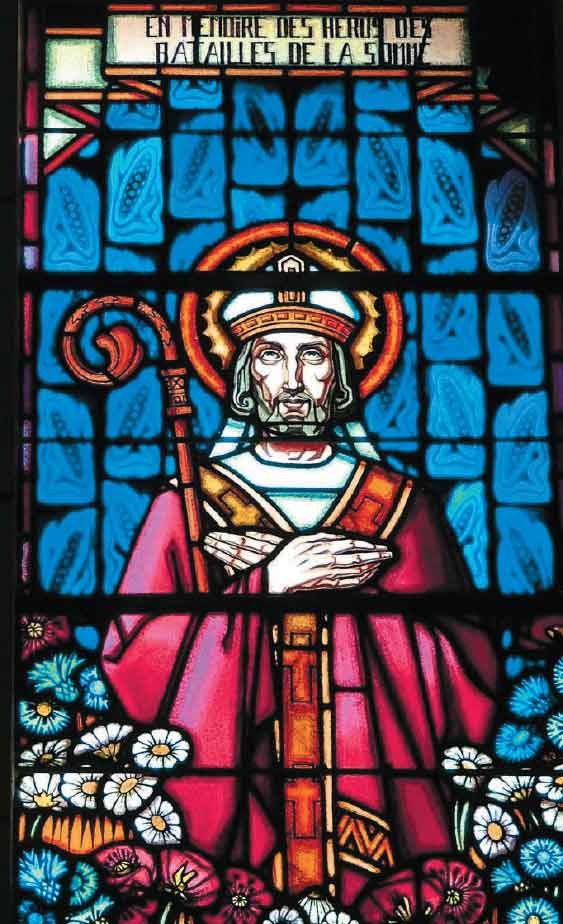
Stained glass window in the Rancourt Chapel to the Somme Battles
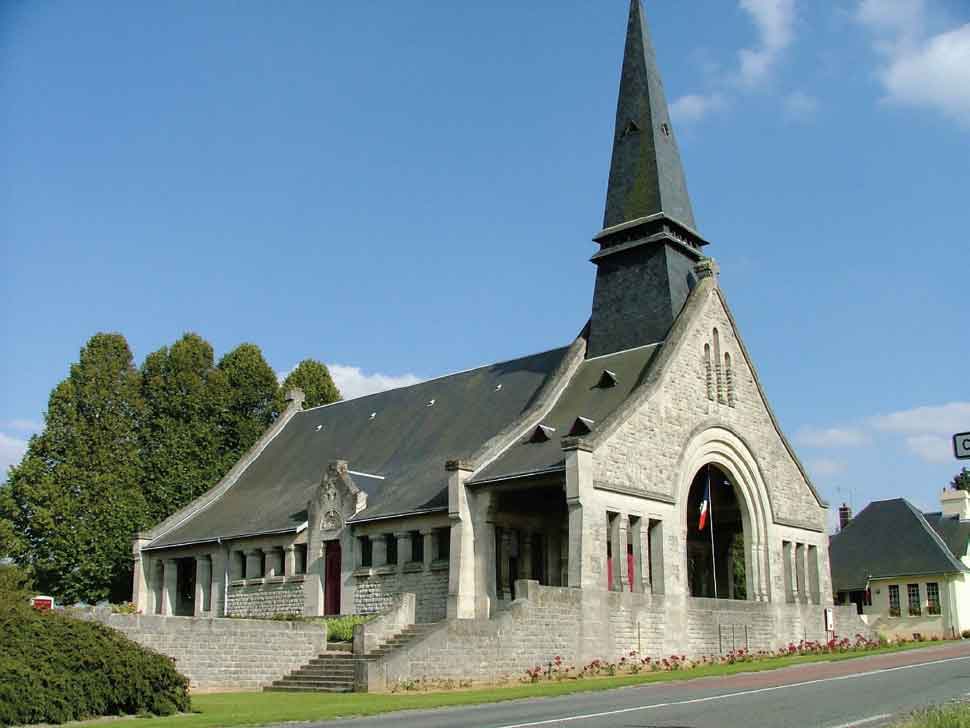
Souvenir Français Chapel & Museum, Rancourt
The body of the Duke (among his ancestors was one of Louis XIII’s most famous generals) was returned to the family château at Josselin in the Morbihan and buried in the crypt of the chapel. His death was mourned by his friend, Jean Cocteau (see Itinerary Three). The Count and Countess Rohan-Chabot of the same family were present at the inauguration of the Airborne Forces cross in Ranville CWGC Cemetery in September 1944. To the left of the doorway in the left wall are two British plaques. One is to Lt Niel Shaw Stewart of the Rifle Brigade who was killed leading ‘C’ company in the attack on Guillemont on 21 August, age 22. He is buried in Delville Wood CWGC Cemetery. The other is to Lt Alan Humphrey Cheetham, of the 2nd Bn, Duke of Wellingtons, age 20 who was killed at Sailly-Saillisel on the night of 15th/16th December 1916. He is commemorated on the Thiépval Memorial.
Adjoining the Chapel is a small Museum, now renovated and with interesting exhibits added to the original items as diverse as the medical instruments that were presented by the Brooklyn Post No 2 Jewish War Vets of the US on 4 July 1918, to a model of the ‘Long Max’ gun from Laon and models of World War II rocket launching pads in the district. It is maintained by guardian, M J-P Desain who also runs the Welcome Centre, approached through a door on the opposite side of the Chapel. It has a small Information Centre, souvenir shop and WC. Tel: +(0)3 22 85 04 47. E-mail: memorial-rancourt@neuf.fr. Open every day.
Walk into the adjoining cemetery.
• French National Cemetery, Rancourt/16.3 miles/10 minutes/Map 1/44
This is the largest French Military Cemetery on the Somme, with 8,566 burials, of which 3,240 are in four ossuaries. It is a concentration cemetery from all the surrounding battlefields and testifies to the sacrifice of the French from September to November 1916 in the region. It ranks in emotional importance as a focal point of remembrance to the French as do the Thiépval Memorial and Tyne Cot Cemetery in the Ypres Salient to the British. Because of the closeness of the three different nationality cemeteries here, joint Anglo-French-German ceremonies are held on important anniversaries. It also affords an opportunity to compare and contrast the different styles of remembrance of the three nationalities.
Continue into the village.
The 2 star Logis de France Hôtel Prieuré, part of the same group as the Royal Picardie at Albert and La Paix at Bapaume, is on the right, Tel: +(0)3 22 85 04 43. E-mail: contact@hotel-le-prieure.fr It has a ‘restaurant gastronomique’.
Continue on the D1017 to the British cemetery to the left on the outskirts of Sailly-Saillisel and park. Traffic moves very quickly on this road and it is very difficult to stop.
• Sailly-Saillisel British Cemetery/17.8 miles/5 minutes/Map 1/44a/GPS: 50.01966 2.91007
Sailly-Saillisel was the scene of desperate fighting on 28 August 1914, when the French Reserves were trying to stop the German rush ‘nach Paris’. The consequences were terrible for the French – see le Transloy below.
The village was captured by the French in 1916 and remained in Allied hands until the German Offensive of March 1918, when it fell on the 24th. It was retaken by the 18th and 38th (Welsh) Division on 1 September 1918. The Cemetery records 559 UK, 12 Australian, 7 Newfoundland and 185 unknown burials and 8 Special Memorials. It was made after the Armistice by the concentration of small graveyards, including ‘Charing Cross’ and ‘Aldershot’. After the war the London connection was continued. Marylebone paid for the ‘Salle des Fêtes’ in the rebuilt village.
Continue on the D1017/917 to le Transloy and turn left at the T junction with the D19, following signs to the French ‘Monument aux 800 Morts’. Drive to the French Poilu in the village, keeping to the right.
• War Memorial, Le Transloy/21.8 miles/5 minutes/GPS: 50.05766 2.88889
This commemorates victims from the Franco-Prussian War of 1870-1 and cites the Order of the Day of 24 September 1920 which awards the village with the Croix de Guerre for suffering complete destruction in the bombardments, and for always showing dignity and courage in its afflictions under enemy domination. Of the long list of towns and villages thus honoured, many are on the Somme and nearby battlefields, notably Albert, Amiens, Arras, Assevillers, Authuille, Aveluy, Bapaume, Beaucourt, Beaumont-Hamel, Bouchavesnes, Bray, Chipilly, Combles, Contalmaison, Corbie, Courcelette, Dompierre, Doullens, Feuillières, Flaucourt, Flers, Fouilloy, Fricourt, Ginchy, Guillemont, Heilly, Hem-Monacu, Lihons, Mailly-Maillet, Mametz, Maricourt, Montauban, Mont St Quentin, Ovillers, Péronne, Pozières, Proyart, Sailly-Saillisel, Suzanne, Thiépval, Vermandovillers and Villers Bretonneux.
The ridge upon which le Transloy sits was the target of a series of attacks during October 1916 which were opened by 56th Division of XIV Corps on 7 October. Heavy rain turned the fields into liquid mud and the Corps Commander, Lord Cavan, questioned whether the continuous effort was worth the loss in men. French forces were attacking alongside to the south and the British efforts may have been part of the C-in-C’s ‘co-operation policy’. In any event, the ridge was not taken.
Continue right of the Memorial to the cemetery on the left at the far edge of the village and drive into the car park.
• Monument to 800 Dead of 28 August 1914/22.2 miles/15 minutes/Map I3/GPS: 50.05440 2.88160
There are several Memorials inside the gate beside the local cimetière communal. On the wall to the left are individual Plaques and photographs and there are two major Monuments – one a tall column to the 800 braves who fell on 28 August and 26 September 1914, erected by their families (with a Plaque on the back saying that the names of the missing are held in the archives in the Mairie), the other, a marble wall carrying the names of the missing 792 soldiers ‘Morts Pour la France’ at le Transloy on 28 August and 26 September 1914 who rest here. Another stone on a mass grave commemorates ten officers who fell on those same dates and there are individual graves to 2nd Lt Emil Rabache of the 338th RI from Limoges, 28 August 1914 age 23, Croix de Guerre, 2nd Lt Reservist Alfred Grouzillard, 28 June 1879-28 August 1914, Chevalier de la Légion d’Honneur; a cross to Capt Anatole Thepernier, 26th RIT, 26 September 1914 and the tomb of sixteen other named NCOs and soldiers of 26 September.
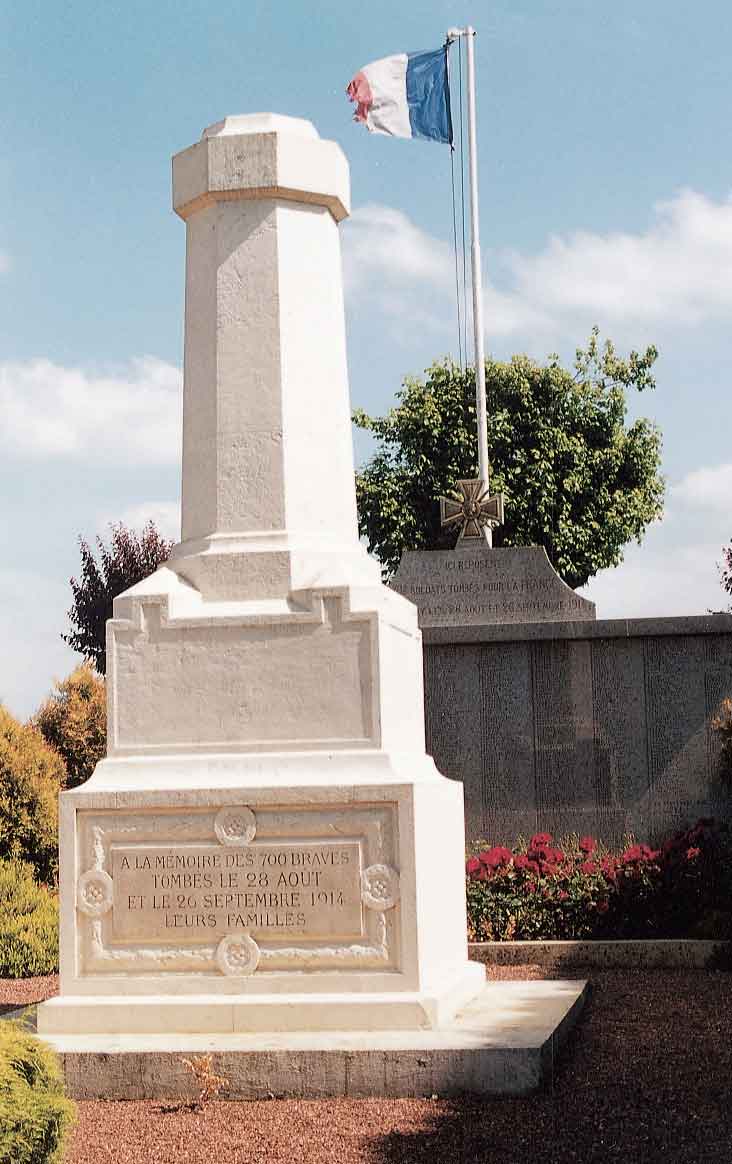
Memorial Column, Le Transloy
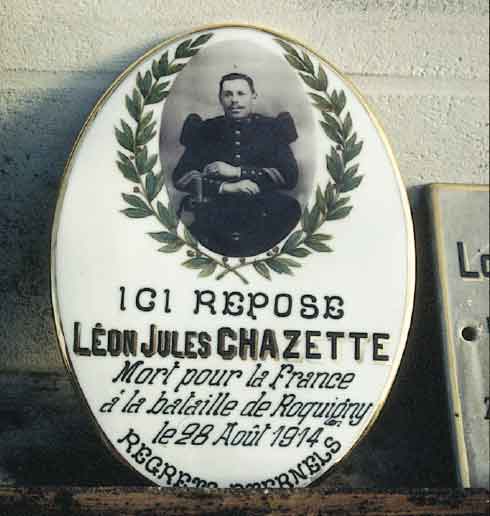
Individual plaques to two of the ‘800 morts’, le Transloy Cemetery
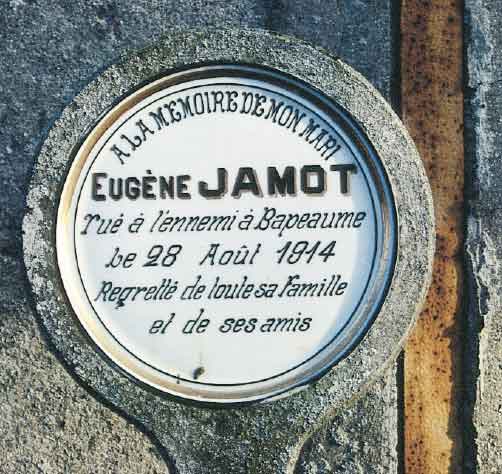
These reminders of this massive slaughter are extremely moving. Even locally, the full facts are little known today. The story is, however, fully documented in a detailed study of the tragic episode called 28 August 1914. Les Combats de le Transloy, Rocquigny, Sailly-Saillisel, by Maurice Pasquet, grandson of one of the participants, who had been brought up on stories of the massacre told by his widowed grandmother. He uses regimental histories, diaries and personal accounts by survivors to piece together what happened. The story starts at Mons. The British formed the left-hand end of the French line. On 23 August 1914 they briefly held Von Kluck’s right wing at Mons and began a three-day withdrawal to le Cateau. Gen Joffre, seeing that his left wing was now exposed, rallied forces to fill the gap left by the British and on 24/25 August, untried French reservists of the 61st and 62nd Divisions were rushed to Arras by train. Their orders were to extend the British line to the west. Meanwhile the British made a brief stand at le Cateau on 26 August and then began their long retreat to the Marne. Von Kluck declined to follow the British, and sent Von Linsingen’s 2nd Army Corps west to Cambrai (where they arrived in the area of Marcoing, which would feature in the 1917 battle) on 26/27 August. The French, now unable to contact the retreating BEF, sat astride Bapaume – the 61st Div to the west, the 62nd Div to the east.
At this point the subsequent actions can be more easily followed by referring to the Michelin map 236, folds 26 and 27.
On 27 August 1914 the German forces, spearheaded by the 49th and 149th Infantry Regiments, headed south-west, roughly along the line of the A2-E19 motorway from Cambrai and reached Sailly-Saillisel (where the motorway crosses the N17). En route they had flank engagements with the French 62nd Inf Div who were in the area between the A2-E19 and A1-E15 motorways south-east of Bapaume. Thus the Germans were south of the French divisions. That night there was fighting at Sailly-Saillisel and Von Kluck, anxious to maintain his advance, yet keen to isolate the French, ordered that the 49th and 149th should manoeuvre to prevent the French from crossing the Somme (which they were vainly and tardily attempting to do in order to block the Germans in their rush ‘nach Paris’). The following morning, in thick fog, the two German regiments moved north along the line of the N17 at le Transloy and hit the flank of the unsuspecting 338th Regt of 123rd Bde of 62nd Div coming, in marching formation, from the north-east in what they thought was pursuit of the Germans. The 338th Regt suffered heavy casualties from the encounter – all its officers were killed or wounded – and the accompanying 278th Regiment, despite attempting to march around the Germans to the north, was also cut down. By 1000 hours the French were falling back to Arras, leaving behind some 1,200 prisoners and a battlefield littered with materiel – much of which the Germans collected. Von Kluck, however, was not pleased with what would seem to be an overwhelming victory. His orders for the 28th had been ‘to cross the Somme between Corbie and Nesle’. The French, despite their horrendous casualties, had delayed the Germans by as much as the British had done at Mons and le Cateau.
At the end of the day on 28 August, the normally peaceful fields around le Transloy looked like a vision from the Apocalypse, much as the battlefield of Waterloo had looked on the night of 15 June 1815. It had been a scorchingly hot day and the wounded suffered on the battlefield, lying amongst their dead comrades. There are varied reports of the victors’ treatment of the victims. In some places the Germans gave water, basic first aid and an attempt at some shelter from the sun. In others the wounded were put out of their misery – and not for humane reasons. The shocked inhabitants of the village rallied. Farmers brought up their vehicles and carts to move the wounded to improvised hospitals. In the absence of any professional medical help, the women and girls became caring nurses. The next day motor ambulances arrived from Arras and the evacuation of the wounded was completed by nightfall. ‘Après les blessés, les morts’, was the villagers’ priority. Their wounded in safe hands, on the third day after the battle they set out to pick up the dead who lay on the plain between Rocquigny, Sailly-Saillisel and Morval. Again with their farm carts and vehicles, they brought the bodies, by now in an advanced state of decomposition because of the heat, to the small cemetery at le Transloy and gently searched for identification. Organized by the Curé, M. Blasart, wallets, identification discs and papers, photographs of loved ones, personal possessions – all were lovingly tied up in knotted handkerchiefs and labelled with a name. Then a huge ditch, 10 metres long and 4 metres wide was dug and the bodies were reverently laid, side by side ‘comme à la parade’. Ten officers were buried in a nearby mass grave.
The inhabitants were soon evacuated, and when they were allowed to return in 1919 to find their village – and the cemetery – completely destroyed, the mayor, M. Malet, received a flood of letters from relatives of the dead, wanting to know details of their burial. By 1920, the villagers had found the site of the mass grave and the first landscaping took place, so that on 5 September 1920 relatives and dignitaries were able to join in a ceremony of commemoration. A subscription was raised for a suitable monument and on 25 September 1921 it was inaugurated. From then on a ceremony was held annually on the 3rd Sunday of September and in 1927 marble panels, inscribed with the names of the 800 ‘braves’, was unveiled.
When the Germans finally pushed their line well south towards the Somme they used the relatively high ground of the cemetery (then quite small) as a formidable defensive position, building a near semi-circle of trenches and multiple lines of barbed wire around it to a radius of 250 yards.
Return to the D917 and turn left. Continue to the junction with the D11 in Beaulencourt. Turn right signed to Villers au Flos and continue to the village crossroads and then turn left, following signs along a small meandering road, to the German Cemetery. It is approached down a long brick path.
• German Cemetery & XIV Reserve Korps Memorial, Villers au Flos/24.7 miles/10 minutes/Map 1/45/GPS: 50.08273 2.90193
The Cemetery contains 2,449 burials under black crosses, but with only two, rather than the usual four, men marked on each. Most of the burials are of July 1916. At the back of the cemetery is a high stone memorial tower to the XIV Reserve Korps, 1914-18 which was originally in the cemetery at Bapaume. The X1Vth held this area during the 1916 battles (see the Holts’ map).
Return to the junction with the D917, turn right and continue the Itinerary by following signs into Bapaume Centre.
• Bapaume/28.8 miles
End of Itinerary Four
OR
Extra Visit to H.A.C. Cemetery, Ecoust-St Mein (Map 1/51, GPS: 50.17186 2.90506); Bullecourt and the Australian/British 1917 Actions: Museum (Map 1/46, GPS: 50.19181 2.92723), Slouch Hat & Tank Crew Memorials (Map 1/47, GPS: 50.19292 2.92963), Digger Memorial Park (Map 1/48, GPS: 50.19477 2.93833), Memorial to the Missing (Map 1/49, GPS: 50.19528 2.94388)
Round trip: 17 miles. Approximate time: 80 minutes.
From Bapaume take the D956 signed to Douai and continue towards St Ecoust St Mein and stop at the cemetery on the left.
H.A.C Cemetery, Ecoust-St Mein (Map 1/51)
The village and enemy positions around it were captured by the 4th & 7th Australian Divisions on 2 April 1917. The Cemetery was begun by 7th Division after the battle when 27 members of the Honourable Artillery Company who fell (with one exception) on 31 March or 1 April were buried in what is now Plot I, Row A. After the German counter-attack near Lagnicourt on 15 April, 12 Australian Gunners were buried in the same row. Rows B, C and part of D were made in August and September 1918 when the ground was recaptured by the 3rd Division. After the Armistice graves were added from the battlefields of Ecoust and Bullecourt and other small burial grounds, including French, German and Russian casualties. Now there are nearly 2,000 WW1 casualties (over half of which are unidentified (and one is emotionally hit by seeing row after row of ‘Known Unto God’ burials here) and there are Special Memorials to 17 UK, 14 Australian and 34 UK soldiers whose graves were destroyed by shellfire.
Here are buried: Maj Francis Fitzgerald (‘Ferdy’) Waldron (qv), 60th Sqn RFC, age 29, 3 July 1916, only son of Brig-Gen F. Waldron, CB, RH, RFA and Capt Auberon Thomas (‘Bron’) Herbert, 8th Baron Lucas and 11th Baron Dingwall, 22nd Sqn RFC, 3 November 1916. He is also listed in the Cemetery Report as ‘Capt Auberon Thomas Herbert Lucas, “Alias”, 3 November 1916’ and additionally ‘5th Baron. SEE HERBERT, the true family name’. Maurice Baring (qv) wrote a poem entitled In Memoriam, A.H. (Auberon Herbert, Captain Lord Lucas, RFC killed November 3 1916). ‘Bron’ Lucas was one of the great personalities of his time. An Oxford (Balliol) rowing ‘Blue’ he went to cover the S. African war as Times correspondent where he lost a leg. This did not deter him from hunting and shooting on his return. He entered Parliament and rose to the position of President of the Board of Agriculture in 1914. When war broke out he joined the Hampshire Yeomanry and despite being vastly over-age (39) managed to join the RFC, serving in Egypt with 13 Sqn where he was M.I.D. In October 1916 he was given command of 22 Sqn, stationed at Bertangles (qv) where Maurice Baring (first Henderson’s and later Trenchard’s Private Secretary) visited him. On 3 November he was at first posted as missing but later was reported to have been shot in the neck but able to land his machine. He died shortly after and was buried ‘near Bapaume’. His grave was then lost and not rediscovered until the Allied advance to Victory in autumn 1918.
Also buried here is Rifleman John Woodhouse, KRRC who was ‘Shot at Dawn’ on 4 October 1917 for desertion, and the poet, Capt Arthur Graeme West. This unconventional war poet, despite defective eyesight, joined the 16th Public Schools Battalion of the Middlesex Regiment as a private in February 1915. He was killed by a sniper on 3 April 1917 in his trench near Barastre, to the east of Bapaume. In August 1916 he had been commissioned in the 6th Bn, the Oxs and Bucks. Educated at Blundells School and Balliol College, Oxford, he was an admirer of Bertrand Russell and veered towards atheism. His poems reflect his non-conformity to the usual patriotic and resigned public school attitude. ‘God! How I Hate You, You Young Cheerful Men!’, he wrote in early 1916.
AN EXCEPTIONAL CEREMONY
It was here on Tuesday 23 April 2013 that the Re-interment of four soldiers of the Honourable Artillery Company took place. Their remains had been discovered by a local farmer in a nearby field in 2009. Two of the four were identified as Lt John Harold Pritchard (by a silver identity bracelet) and Pte Christopher Douglas Elphick (by a signet ring bearing his initials). Because a large number of family members of both men had been found and attended the ceremony, it attracted much press attention by the British and French media which greatly added to the poignancy of the day.
We have chosen to feature this ceremony at unusual length for one of our guidebooks as it epitomised the caring, superbly accurate, highly professional and quietly efficient work of the Commonwealth War Graves Commission (see also page 325), who unobtrusively prepared the graves area and backed up the immaculate and reverential burial party in the perfectly maintained Cemetery: of the Joint Casualty and Compassionate Centre (see also page 328) who deal with the newly found remains, identification and liaison with any family members; of the HAC, who buried four of their own, who died 96 years ago, with pride, gentle precision and compassion and, finally, of the MOD Press Service who bring the event to the attention of the public so that they are aware of the work of the aforementioned organisations.
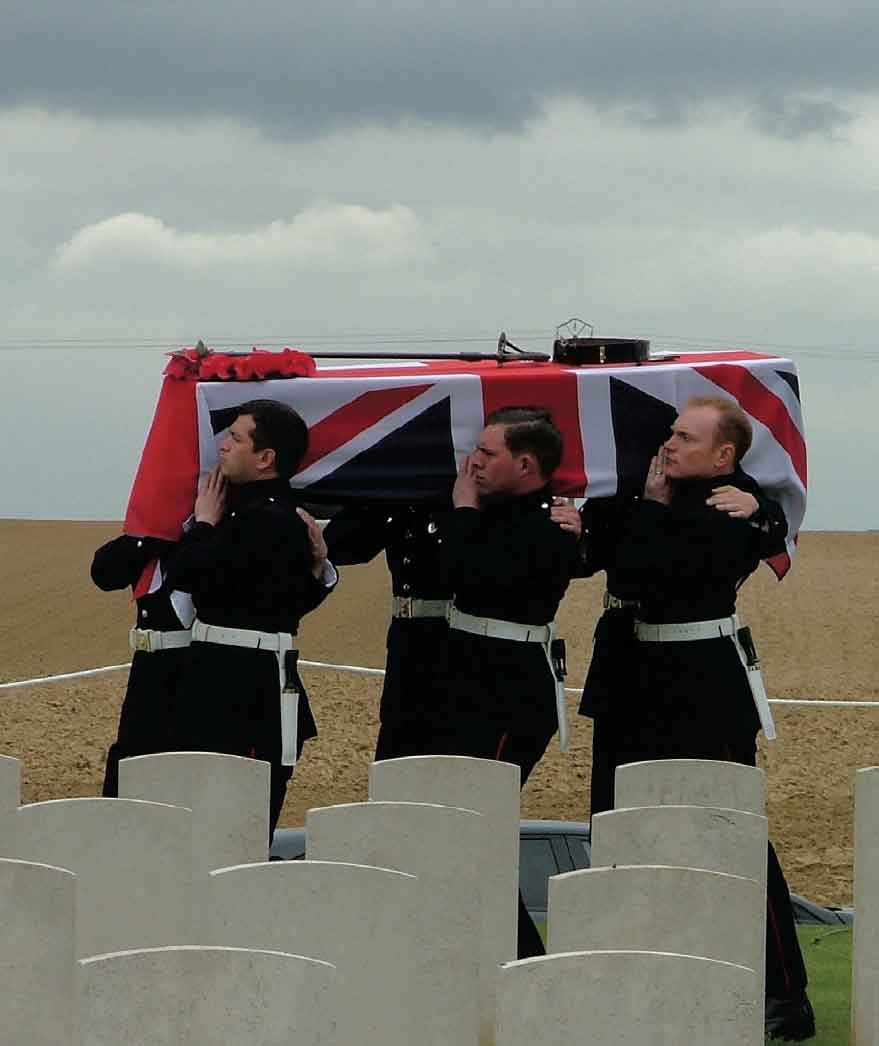
Entry of Lt Pritchard’s coffin bearing his sword, Ecoust St Mein CWGC Cemetery
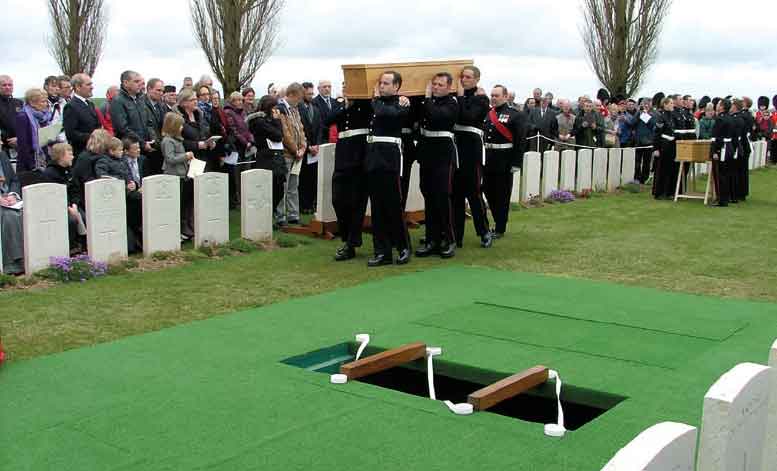
Burial party approaching the grave
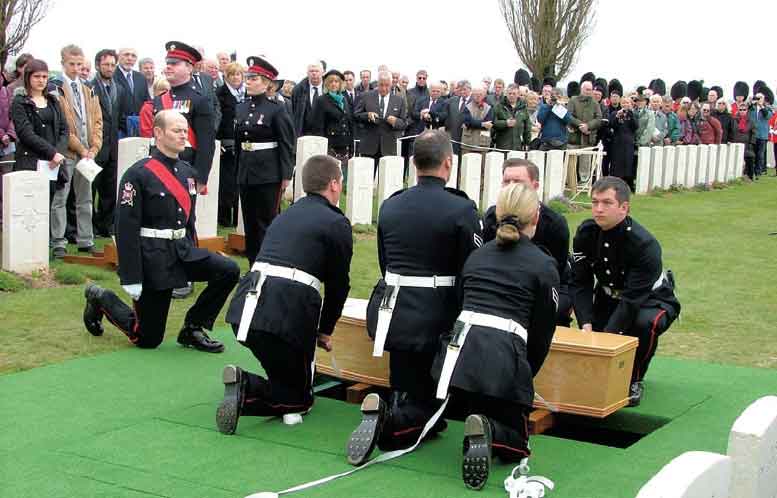
Lowering the coffin
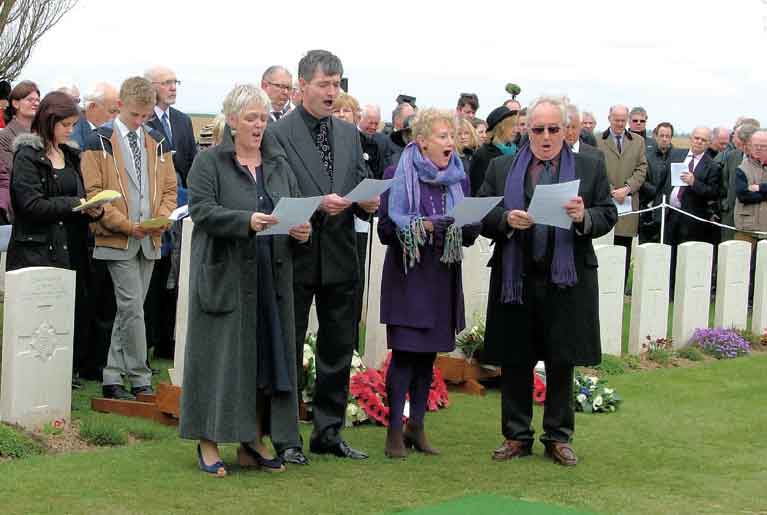
The Pritchard Family singing
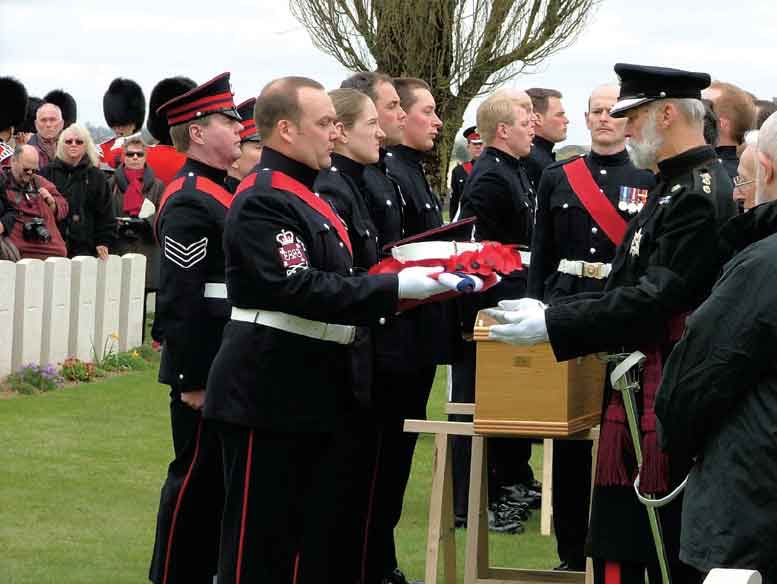
Prince Michael of Kent receives the folded flag
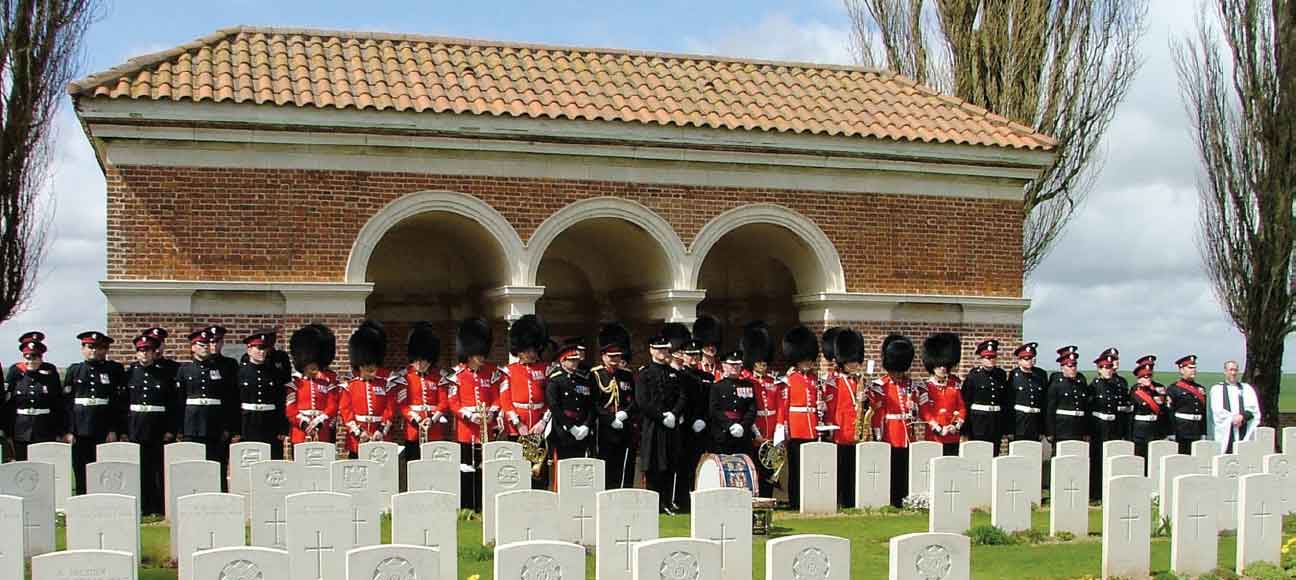
The HAC delegation
The service was conducted by the Rev Mark Speeks CF and the Rev David Reindorp CF (Retd) with participation by Prince Michael of Kent, Royal Hon Col; Lt Col Howard Wilkinson and RSM WO1 Andy Campbell of the HAC and family members. Unusually, but movingly, the service was completed by four members of the Pritchard family singing Tennyson’s Crossing the Bar, the song that Lt Pritchard sang to his mother before he finally left for the front.
A unique element of the burial was that on the coffin of Lt Pritchard was his sword. It was lost when he was killed and somehow found its way into the hands of an American collector, Mark Cain, who generously returned it to the family. It is visible in our picture which, with the others, tell the story of the re-burial.
[N.B.] By driving some 1.5 km to the south east Vraucourt Copse CWGC Cemetery (GPS: 50.15907 2.91534) may be reached. In it is buried Pte Hugh McIver, MC, MM + Bar (qv).
As part of the Hindenberg Line the Germans had built a small salient of barbed wire and trenches around Bullecourt which projected forward towards you. As you enter the village the forward edge of the salient stretched across the road to about 500 yards each side and then bent back away from you. Fighting therefore went on from three directions.
Continue on the D956 into Bullecourt. Turn left signed Musée Militaire and immediately stop on the right at No. 1bis rue d’Arras.
Bullecourt 1917 Museum of Jean and Denise Letaille.
For many years the highlight of a visit to Bullecourt was to go to the Private Museum of Monsieur Letaille where one was assured of a warm welcome from Jean and his wife Denise. This extraordinary couple had worked tirelessly in ensuring that the Battle of Bullecourt and its many Australian and British casualties would never be forgotten, being instrumental in the erection of the various memorials and trails that visitors can now enjoy in the area. The work of the former Mayor and his wife was recognised by the award of the Medal of Australia.
Their wonderful collection, housed in a barn in their courtyard, was built up over the years from objects found in the surrounding countryside and donations from many contributors. It contained many personal possessions (including some of Sergeant Jack White, whose remains were found near Bullecourt and reburied in October 1995 (qv)) and fascinating accounts, e.g. of Captain Albert Jacka, who won his VC (the first to be awarded to a Commonwealth soldier) as a Lance-Corporal in May 1915 at Courtney’s Post in Gallipoli. There were collections of entrenching tools, ammunition boxes, weapons etc.
After Denise’s death, Jean’s health declined and he came to an arrangement with the Australian Government to donate his collection to them and in return they would house and care for it in the modern Museum you are now about to visit. He died in tragic circumstances on 10 March 2012, a month before the official opening. The couple are strongly featured and honoured in the Museum which bears their name.
There is a WC, access for the disabled and a small books stall. Open: Mon-Sun 1400-1800. Entrance fee payable. Audio-guide in French and English. Tel: + (0)3 21 55 33 20. E-mail: musee-bullecourt1917@orange.fr
Turn round, return to the main road, turn left and stop near the Town Hall. Opposite is
The Slouch Hat Memorial (Map 1/47), a felt Digger’s hat which has been bronzed, in ‘Square du Souvenir Français’. The brick base bears the badges of the 1st, 2nd, 4th and 5th AIF, the 58th (London) Division, the 62nd (W Riding) Division and the 7th Division.
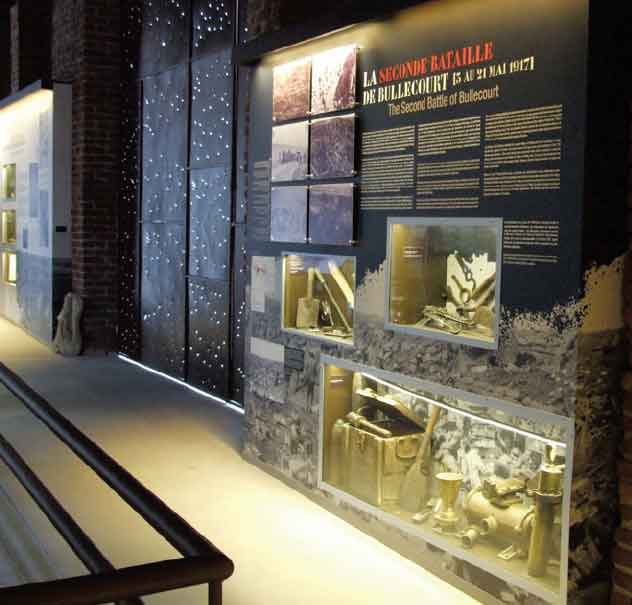
Display in Australian Letaille Museum, Bullecourt
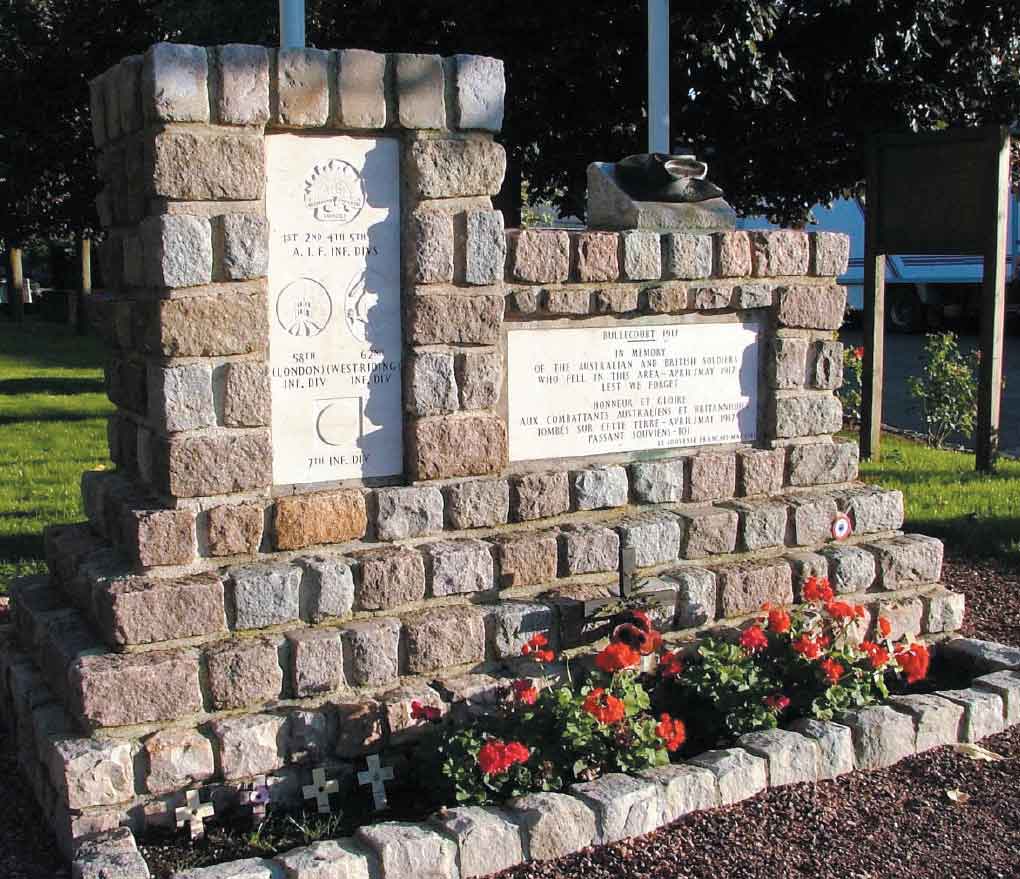
‘Slouch Hat’ Memorial, Bullecourt.
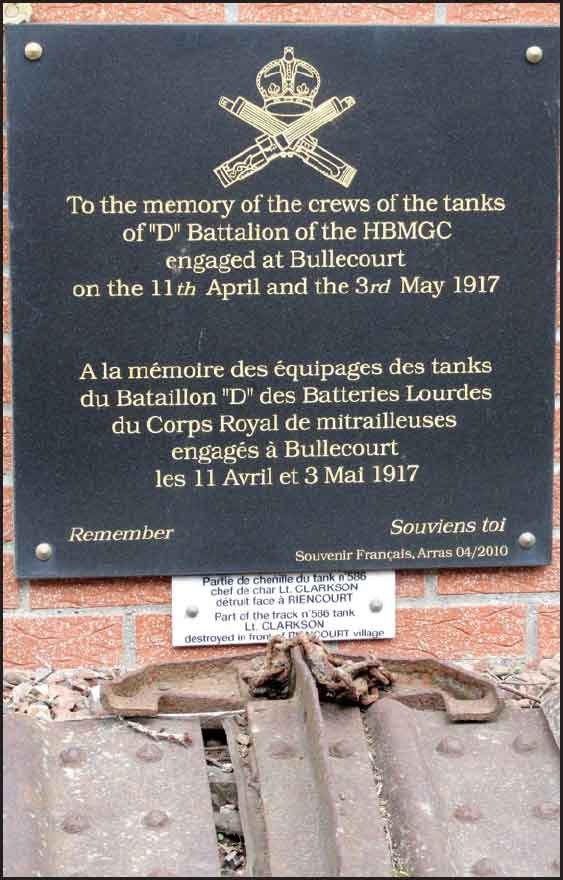
Memorial to Heavy Bde, Machine Gun Corps, Bullecourt
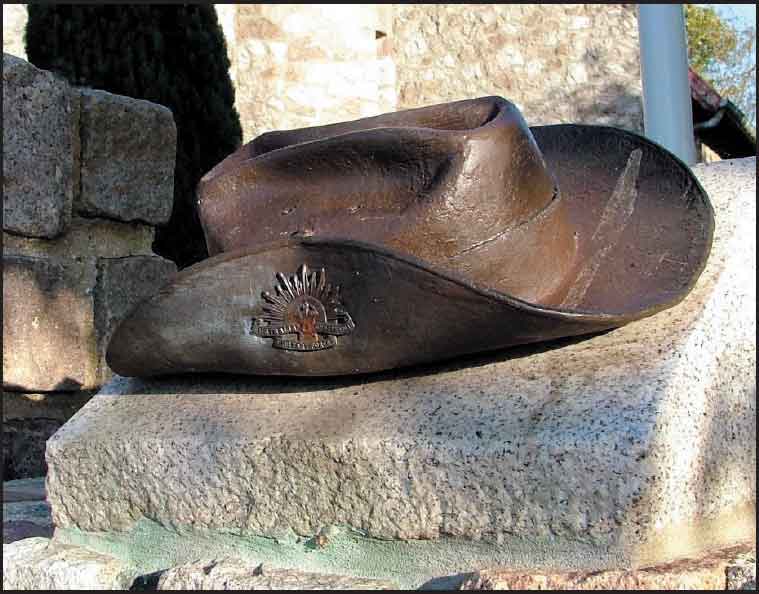
Detail of the Slouch Hat
The first attempt to seize Bullecourt began on 11 April in driving snow when two brigades of the 4th Australian Division, supposedly led by twelve tanks, set out to take the village and its neighbour, Riencourt. Unfortunately the tanks failed – nine had direct hits and the others had mechanical problems. To compound the difficulties the artillery support was insufficient, due to ammunition shortage and lack of information about the movements of the forward troops – some 17th Lancers coming up to support came under ‘friendly fire’. Despite valiant and determined efforts by the Australians they were unable to consolidate the small gains that they had made and fell back in confusion, though for a brief period they had held one small part of the Hindenburg Line without a supporting barrage. One observer called the 11th “a day of unrelieved disaster”: Australian losses were some 3,000.
To the right of this Memorial is a Memorial to the Tank Crews of D Bn HBMGC who were engaged at Bullecourt on 3 May 1917. It was erected by Souvenir Français, Arras, in April 2010. Below it is part of the track of tank No 586 of L. Clarkson, destroyed near the village of Riencourt. Above is a plan of the 4 points of the Australian Battlefield Track around the village.
Continue and fork right on the rue des Australiens following the green CWGC sign to the Australian Memorial on the right.
Digger’s Memorial Park (Map 1/48). To the left is a bench with the Plaque SEGPA Marquion 1997 and there is a Ross Bastiaan bronze Plaque. The fine bronze statue is sacred to the memory of 10,000 members of the AIF who were killed and wounded in the two battles of Bullecourt, April, May 1917 and to the Australian dead and their comrades in arms who lie here forever in the soil of France. It was dedicated on ANZAC Day 1992, the 75th Anniversary. On the reverse the sculptor Peter Corlett explains how he has depicted ‘the characteristics for which the Australians are known – sturdy, arcadian, audacious, resolute’ and that the uniform is authentic.
The second attempt to take Bullecourt began on 3 May and formed part of an overall assault on a front of some 15 miles by 14 divisions, with the town at the right flank. Although the attack had been carefully rehearsed it was, like the first attempt, too complicated. Supporting artillery reduced Bullecourt to ruins and the Australian 2nd Division led off the attack (this time without tanks) later being joined by the 1st and 5th Divisions. The 5th Brigade on the right failed to make any impression, while to its left the 6th Brigade made gains that it resolutely held against fierce counter-attacks by the German 27th Wurttemberg Division. Eventually, on 17 May, the last remnants of Bullecourt fell, a progressive achievement involving troops and tanks of the British 7th, 58th and 62nd Divisions. The Australians lost 7,000 men during the fighting and won two VCs: Corporal G.J. Howell (who survived until 1964) and Lieutenant R.V. Moon (who survived until 1986).
Continue up the road to the monument in the bank on the left.

Digger Memorial, Bullecourt
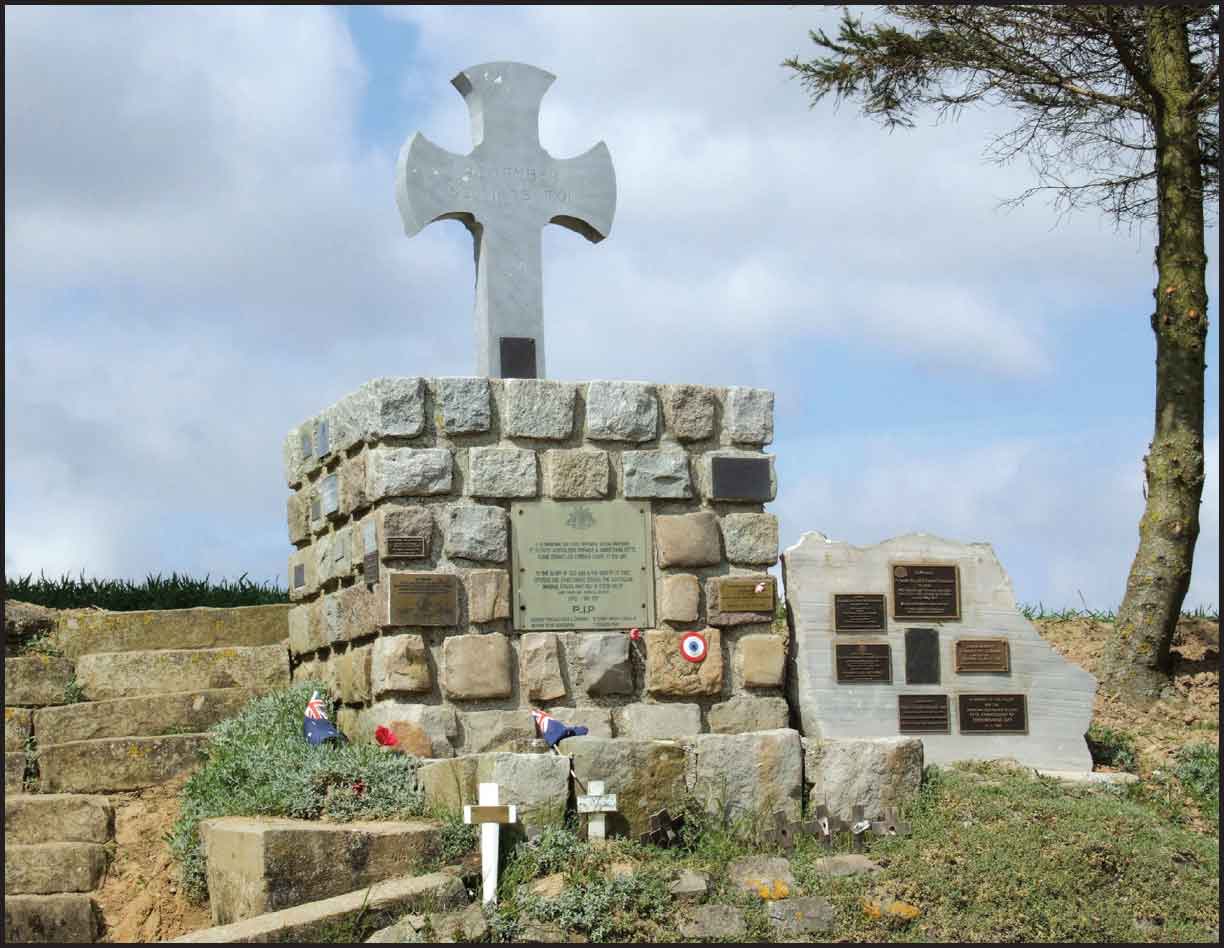
Memorial to 2,423 Missing Australians, Bullecourt
Memorial to 2,423 Australians, missing with no known grave (Map 1/49). This cross, with the words ‘Remember’ was erected in 1982. It is on the Second German Line, on ‘Diagonal Road’. On the side of the base are small personal plaques.
Bunny Hug and Starfish and a trench railway ran roughly north to south. This is Point 4 on the Australian Track (qv).
Return to the Town Hall, park and, if desired, follow the other points on the recommended route by foot. Return to Bapaume.
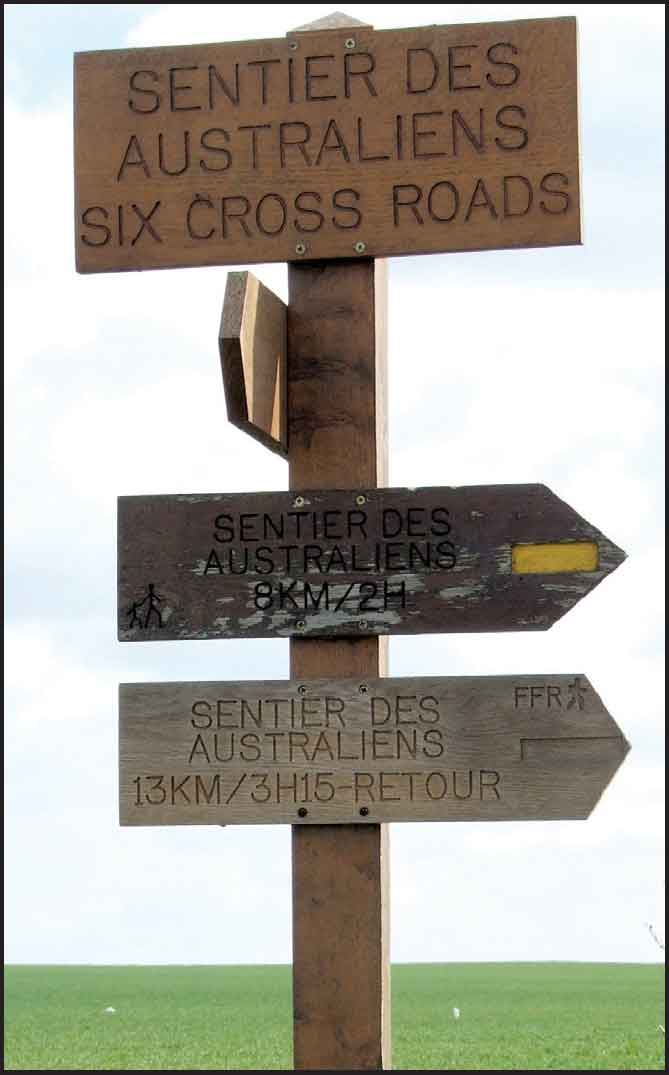
Six Crossroads Point 4 on the Australian Track, Bullecourt
[N.B.] Some 2 miles further north from Bullecourt on the D956 there is a Memorial to the 15th Bn Canadian Highlanders (GPS: 50.218854 2.953521). It was unveiled in April 2010 and commemorates an attack by the 15th on the village and the high ground behind the Memorial of 1 September 1918.
End of Itinerary Four and Extra Visit
